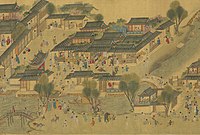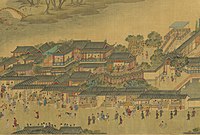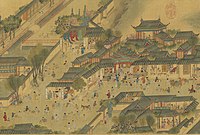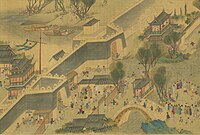Ming dynasty
Great Ming
| |||||||||||||||||||
|---|---|---|---|---|---|---|---|---|---|---|---|---|---|---|---|---|---|---|---|
| 1368–1644 | |||||||||||||||||||
 Ming China in 1415 during the reign of theYongle Emperor | |||||||||||||||||||
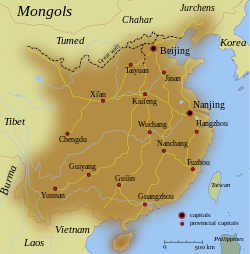 Ming China around 1580 | |||||||||||||||||||
| Capital | |||||||||||||||||||
| Common languages |
| ||||||||||||||||||
| Religion | |||||||||||||||||||
| Government | Absolute monarchy | ||||||||||||||||||
| Emperor | |||||||||||||||||||
• 1368–1398 (first) | Hongwu Emperor | ||||||||||||||||||
• 1402–1424 | Yongle Emperor | ||||||||||||||||||
• 1572–1620 (longest) | Wanli Emperor | ||||||||||||||||||
• 1627–1644 (last) | Chongzhen Emperor | ||||||||||||||||||
| Historical era | Early modern | ||||||||||||||||||
| 23 January 1368 | |||||||||||||||||||
•Beijingdesignated as capital | 28 October 1420 | ||||||||||||||||||
| 25 April 1644 | |||||||||||||||||||
• End of theSouthern Ming[b] | 1662 | ||||||||||||||||||
| Area | |||||||||||||||||||
| 1450[1][2] | 6,500,000 km2(2,500,000 sq mi) | ||||||||||||||||||
| Population | |||||||||||||||||||
• 1393[3] | 65,000,000 | ||||||||||||||||||
• 1500[4] | 125,000,000 | ||||||||||||||||||
• 1600[5] | 160,000,000 | ||||||||||||||||||
| GDP(nominal) | estimate | ||||||||||||||||||
• Per capita | |||||||||||||||||||
| Currency |
| ||||||||||||||||||
| |||||||||||||||||||
| Ming dynasty | |||||||||||||||||||||||||||||||||
|---|---|---|---|---|---|---|---|---|---|---|---|---|---|---|---|---|---|---|---|---|---|---|---|---|---|---|---|---|---|---|---|---|---|
"Ming dynasty" in Chinese characters | |||||||||||||||||||||||||||||||||
| Chinese | Minh triều | ||||||||||||||||||||||||||||||||
| |||||||||||||||||||||||||||||||||
| Dynastic name | |||||||||||||||||||||||||||||||||
| Chinese | Đại minh | ||||||||||||||||||||||||||||||||
| |||||||||||||||||||||||||||||||||
| Part ofa serieson the |
| History of China |
|---|
TheMing dynasty(⫽mɪŋ⫽MING),[7]officially theGreat Ming,was animperial dynasty of China,ruling from 1368 to 1644 following the collapse of theMongol-ledYuan dynasty.The Ming dynasty was the last imperial dynasty of China ruled by theHan people,the majority ethnic group in China. Although the primary capital ofBeijingfell in 1644 to a rebellion led byLi Zicheng(who established the short-livedShun dynasty), numerousrump regimesruled by remnants of theMing imperial family—collectively called theSouthern Ming—survived until 1662.[c]
The Ming dynasty's founder, theHongwu Emperor(r. 1368–1398), attempted to create a society of self-sufficient rural communities ordered in a rigid, immobile system that would guarantee and support a permanent class of soldiers for his dynasty:[8]the empire's standing army exceeded one million troops and thenavy's dockyards inNanjingwere the largest in the world.[9]He also took great care breaking the power of thecourt eunuchs[10]and unrelated magnates,enfeoffinghis many sons throughout China and attempting to guide these princes through theHuang-Ming Zuxun,a set of published dynastic instructions. This failed when his teenage successor, theJianwen Emperor,attempted to curtail his uncles' power, prompting theJingnan campaign,an uprising that placed the Prince of Yan upon the throne as theYongle Emperorin 1402. The Yongle Emperor established Yan as a secondary capital and renamed itBeijing,constructed theForbidden City,and restored theGrand Canaland the primacy of theimperial examinationsin official appointments. He rewarded his eunuch supporters and employed them as a counterweight against the Confucianscholar-bureaucrats.One eunuch,Zheng He,led seven enormousvoyages of explorationinto theIndian Oceanas far as Arabia and the eastern coasts of Africa. Hongwu and Yongle emperors had alsoexpanded the empire's ruleintoInner Asia.
The rise of new emperors and new factions diminished such extravagances; the capture of theEmperor Yingzong of Mingduring the 1449Tumu Crisisended them completely. The imperial navy was allowed to fall into disrepair whileforced laborconstructed the Liaodong palisade and connected and fortified theGreat Wallinto its modern form. Wide-ranging censuses of the entire empire were conducted decennially, but the desire to avoid labor and taxes and the difficulty of storing and reviewing the enormous archives at Nanjing hampered accurate figures.[8]Estimates for the late-Ming population vary from 160 to 200 million,[d]but necessary revenues were squeezed out of smaller and smaller numbers of farmers as more disappeared from the official records or "donated" their lands to tax-exempt eunuchs or temples.[8]Haijinlaws intended to protect the coasts fromJapanese piratesinstead turned many into smugglers and pirates themselves.
By the 16th century, theexpansion of European trade—though restricted to islands nearGuangzhousuch asMacau—spread theColumbian exchangeof crops, plants, and animals into China, introducingchili pepperstoSichuan cuisineand highly productivemaizeandpotatoes,which diminished famines and spurred population growth. The growth ofPortuguese,Spanish,andDutchtrade created new demand for Chinese products and produced a massive influx ofSouth Americansilver. This abundance of specie remonetized the Ming economy, whose papermoneyhad suffered repeatedhyperinflationand was no longer trusted. While traditional Confucians opposed such a prominent role for commerce and the newly rich it created, theheterodoxyintroduced byWang Yangmingpermitted a more accommodating attitude.Zhang Juzheng's initially successful reforms proved devastating when a slowdown in agriculture was produced by theLittle Ice Age.The value of silver rapidly increased because of a disruption in the supply of imported silver from Spanish and Portuguese sources, making it impossible for Chinese farmers to pay their taxes. Combined with crop failure, floods, andan epidemic,the dynasty collapsed in 1644 as Li Zicheng's rebel forces entered Beijing.[11]Li then established theShun dynasty,but it was defeated shortly afterwards by theManchu-ledEight Bannerarmies of theQing dynasty,with the help of the defecting Ming generalWu Sangui.
History
Founding
Revolt and rebel rivalry
TheMongol-ledYuan dynasty(1271–1368) ruled before the establishment of the Ming dynasty. Explanations for the demise of the Yuan include institutionalized ethnic discrimination against theHan peoplethat stirred resentment and rebellion, overtaxation of areas hard-hit byinflation,and massive flooding of theYellow Riveras a result of the abandonment of irrigation projects.[12]Consequently, agriculture and the economy were in shambles, and rebellion broke out among the hundreds of thousands of peasants called upon to work on repairing the dykes of the Yellow River.[12]A number of Han groups revolted, including theRed Turbansin 1351. The Red Turbans were affiliated with theWhite Lotus,aBuddhistsecret society.Zhu Yuanzhangwas a penniless peasant and Buddhist monk who joined the Red Turbans in 1352; he soon gained a reputation after marrying the foster daughter of a rebel commander.[13]In 1356, Zhu's rebel force captured the city ofNanjing,[14]which he would later establish as the capital of the Ming dynasty.
With theYuan dynastycrumbling, competing rebel groups began fighting for control of the country and thus the right toestablish a new dynasty.In 1363, Zhu Yuanzhang eliminated his archrival and leader of the rebel Han faction,Chen Youliang,in theBattle of Lake Poyang,arguably thelargest naval battle in history.Known for its ambitious use offire ships,Zhu's force of 200,000 Ming sailors were able to defeat a Han rebel force over triple their size, claimed to be 650,000-strong. The victory destroyed the last opposing rebel faction, leaving Zhu Yuanzhang in uncontested control of the bountifulYangtzeRiver Valley and cementing his power in the south. After the dynastic head of the Red Turbans suspiciously died in 1367 while a guest of Zhu, there was no one left who was remotely capable of contesting his march to the throne, and he made his imperial ambitions known by sending an army toward the Yuan capitalDadu(present-dayBeijing) in 1368.[15]The last Yuan emperor fled north to the upper capitalShangdu,and Zhu declared the founding of the Ming dynasty after razing the Yuan palaces in Dadu to the ground;[15]the city was renamed Beiping in the same year.[16]Zhu Yuanzhang took Hongwu, or "Vastly Martial", as hisera name.
Reign of the Hongwu Emperor

Hongwu made an immediate effort to rebuild state infrastructure. He built a 48 km (30 mi) longwall around Nanjing,as well as new palaces and government halls.[15]TheHistory of Mingstates that as early as 1364 Zhu Yuanzhang had begun drafting a newConfucianlaw code, theDa Ming Lü,which was completed by 1397 and repeated certain clauses found in the oldTang Codeof 653.[17]Hongwu organized a military system known as theweisuo,which was similar to thefubingsystemof theTang dynasty(618–907).
In 1380 Hongwu had the ChancellorHu Weiyongexecuted upon suspicion of a conspiracy plot to overthrow him; after that Hongwu abolished theChancelleryand assumed this role as chief executive and emperor, a precedent mostly followed throughout the Ming period.[18][19]With a growing suspicion of his ministers and subjects, Hongwu established theJinyiwei,a network ofsecret policedrawn from his own palace guard. Some 100,000 people were executed in a series of purges during his rule.[18][20]
The Hongwu Emperor issued many edicts forbidding Mongol practices and proclaiming his intention to purify China of barbarian influence. However, he also sought to use the Yuan legacy to legitimize his authority in China and other areas ruled by the Yuan. He continued policies of the Yuan dynasty such as continued request for Korean concubines and eunuchs, Mongol-style hereditary military institutions, Mongol-style clothing and hats, promoting archery and horseback riding, and having large numbers of Mongols serve in the Ming military. Until the late 16th century Mongols still constituted one-in-three officers serving in capital forces like theEmbroidered Uniform Guard,and other peoples such asJurchenswere also prominent.[21]He frequently wrote to Mongol, Japanese, Korean, Jurchen, Tibetan, and Southwest frontier rulers offering advice on their governmental and dynastic policy, and insisted on leaders from these regions visiting the Ming capital for audiences. He resettled 100,000 Mongols into his territory, with many serving as guards in the capital. The emperor also strongly advertised the hospitality and role granted to Chinggisid nobles in his court.[22]
Hongwu insisted that he was not a rebel, and he attempted to justify his conquest of the other rebel warlords by claiming that he was a Yuan subject and had been divinely-appointed to restore order by crushing rebels. Most Chinese elites did not view the Yuan's Mongol ethnicity as grounds to resist or reject it. Hongwu emphasised that he was not conquering territory from the Yuan dynasty but rather from the rebel warlords. He used this line of argument to attempt to persuade Yuan loyalists to join his cause.[23]The Ming used the tribute they received from former Yuan vassals as proof that the Ming had taken over the Yuan's legitimacy. Tribute missions were regularly celebrated with music and dance in the Ming court.[24]
South-Western frontier
Hui Muslim troops settled inChangde,Hunan,after serving the Ming in campaigns against aboriginal tribes.[25]In 1381, the Ming dynasty annexed the areas of the southwest that had once been part of theKingdom of Dalifollowing the successful effort by Hui Muslim Ming armies to defeatYuan-loyalist Mongol and Hui Muslim troops holding out in Yunnan province. TheHuitroops under GeneralMu Ying,who was appointed Governor of Yunnan, were resettled in the region as part of a colonization effort.[26]By the end of the 14th century, some 200,000 military colonists settled some 2,000,000mu(350,000 acres) of land in what is nowYunnanandGuizhou.Roughly half a million more Chinese settlers came in later periods; these migrations caused a major shift in the ethnic make-up of the region, since formerly more than half of the population were non-Han peoples. Resentment over such massive changes in population and the resulting government presence and policies sparked moreMiaoandYaorevolts in 1464 to 1466, which were crushed by an army of 30,000 Ming troops (including 1,000 Mongols) joining the 160,000 localGuangxi.After the scholar and philosopherWang Yangming(1472–1529) suppressed another rebellion in the region, he advocated single, unitary administration of Chinese and indigenous ethnic groups in order to bring aboutsinificationof the local peoples.[27]
Campaign in the North-East
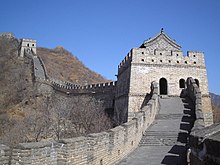
After the overthrow of theMongolYuan dynastyby the Ming dynasty in 1368, Manchuria remained under control of the Mongols of theNorthern Yuan dynastybased inMongolia.Naghachu,a former Yuan official and aUriankhaigeneral of the Northern Yuan dynasty, won hegemony over the Mongol tribes in Manchuria (Liaoyang provinceof the former Yuan dynasty). He grew strong in the northeast, with forces large enough (numbering hundreds of thousands) to threaten invasion of the newly founded Ming dynasty in order to restore the Mongols to power in China. The Ming decided to defeat him instead of waiting for the Mongols to attack. In 1387 the Ming senta military campaign to attack Naghachu,[28]which concluded with the surrender of Naghachu and Ming conquest of Manchuria.
The early Ming court could not, and did not, aspire to the control imposed upon theJurchensin Manchuria by the Mongols, yet it created a norm of organization that would ultimately serve as the main instrument for the relations with peoples along the northeast frontiers. By the end of the Hongwu reign, the essentials of a policy toward the Jurchens had taken shape. Most of the inhabitants of Manchuria, except for theWild Jurchens,were at peace with China. In 1409, under the Yongle Emperor, the Ming Dynasty established theNurgan Regional Military Commissionon the banks of theAmur River,andYishiha,a eunuch ofHaixi Jurchenorigin, was ordered to lead an expedition to the mouth of the Amur to pacify the Wild Jurchens. After the death of Yongle Emperor, the Nurgan Regional Military Commission was abolished in 1435, and the Ming court ceased to have substantial activities there, although the guards continued to exist in Manchuria. Throughout its existence, the Ming established a total of 384 guards ( vệ,wei) and 24 battalions ( sở,suo) in Manchuria, but these were probably only nominal offices and did not necessarily imply political control.[29]By the late Ming period, Ming's political presence in Manchuria has declined significantly.
Relations with Tibet
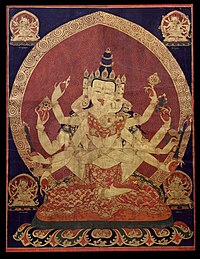
TheMingshi—the official history of the Ming dynasty compiled by theQing dynastyin 1739—states that the Ming established itinerant commanderies overseeing Tibetan administration while also renewing titles of ex-Yuan dynasty officials fromTibetand conferring new princely titles on leaders ofTibetan Buddhist sects.[32]However, Turrell V. Wylie states thatcensorshipin theMingshiin favor of bolstering the Ming emperor's prestige and reputation at all costs obfuscates the nuanced history of Sino-Tibetan relations during the Ming era.[33]
Modern scholars debate whether the Ming dynasty hadsovereigntyover Tibet. Some believe it was a relationship of loosesuzeraintythat was largely cut off when theJiajing Emperor(r. 1521–67) persecuted Buddhism in favor ofDaoismat court.[33][34]Others argue that the significant religious nature of the relationship with Tibetan lamas is underrepresented in modern scholarship.[35][36]Others note the Ming need for Central Asian horses and the need to maintain thetea-horse trade.[37][38][39][40]
The Ming sporadically sent armed forays into Tibet during the 14th century, which the Tibetans successfully resisted.[41][42]Several scholars point out that unlike the preceding Mongols, the Ming dynasty did not garrison permanent troops in Tibet.[43][44]TheWanli Emperor(r. 1572–1620) attempted to reestablish Sino-Tibetan relations in the wake of aMongol-Tibetan allianceinitiated in 1578, an alliance which affected the foreign policy of the subsequent ManchuQing dynasty(1644–1912) in their support for theDalai Lamaof theYellow Hatsect.[33][45][46][47]By the late 16th century, the Mongols proved to be successful armed protectors of the Yellow Hat Dalai Lama after their increasing presence in theAmdoregion, culminating in theconquest of TibetbyGüshi Khan(1582–1655) in 1642,[33][48][49]establishing theKhoshut Khanate.
Reign of the Yongle Emperor
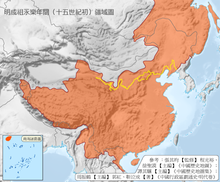
Rise to power

TheHongwu Emperorspecified his grandson Zhu Yunwen as his successor, and he assumed the throne as theJianwen Emperor(r. 1398–1402) after Hongwu's death in 1398. The most powerful of Hongwu's sons, Zhu Di, then the militarily mighty disagreed with this, and soon a political showdown erupted between him and his nephew Jianwen.[50]After Jianwen arrested many of Zhu Di's associates, Zhu Di plotted a rebellion that sparked athree-year civil war.Under the pretext of rescuing the young Jianwen from corrupting officials, Zhu Di personally led forces in the revolt; the palace in Nanjing was burned to the ground, along with Jianwen himself, his wife, mother, and courtiers. Zhu Di assumed the throne as theYongle Emperor(r. 1402–24); his reign is universally viewed by scholars as a "second founding" of the Ming dynasty since he reversed many of his father's policies.[51]
New capital and foreign engagement
Yongle demoted Nanjing to a secondary capital and in 1403 announced the new capital of China was to be at his power base inBeijing.Construction of a new city there lasted from 1407 to 1420, employing hundreds of thousands of workers daily.[52]At the center was the political node of theImperial City,and at the center of this was theForbidden City,the palatial residence of the emperor and his family. By 1553, the Outer City was added to the south, which brought the overall size of Beijing to6.5 by 7 kilometres (4 by4+1⁄2miles).[53]

Beginning in 1405, the Yongle Emperor entrusted his favoredeunuchcommanderZheng He(1371–1433) as the admiral for a gigantic new fleet of ships designated for internationaltributary missions.Among the kingdoms visited by Zheng He, Yongle proclaimed theKingdom of Cochinto be its protectorate.[54]The Chinese hadsent diplomatic missionsover land since theHan dynasty(202 BCE – 220 CE) and engaged inprivate overseas trade,but these missions were unprecedented in grandeur and scale. To service seven different tributary voyages, the Nanjing shipyards constructed two thousand vessels from 1403 to 1419, includingtreasure shipsmeasuring 112 to 134 m (367 to 440 ft) in length and 45 to 54 m (148 to 177 ft) in width.[55]
Yongle usedwoodblock printingto spread Chinese culture. He alsoused the militaryto expand China's borders. This included thebrief occupation of Vietnam,from the initial invasion in 1406 until the Ming withdrawal in 1427 as a result of protractedguerrilla warfareled byLê Lợi,the founder of the VietnameseLê dynasty.[56]
Tumu Crisis and the Ming Mongols
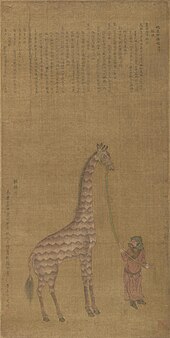
TheOiratleaderEsen Tayisilaunched an invasion into Ming China in July 1449. The chief eunuchWang Zhenencouraged theZhengtong Emperor(r. 1435–49) to lead a force personally to face the Oirats after a recent Ming defeat; the emperor left the capital and put his half-brotherZhu Qiyuin charge of affairs as temporary regent. On 8 September, Esen routed Zhengtong's army, and Zhengtong was captured—an event known as theTumu Crisis.[57]The Oirats held the Zhengtong Emperor for ransom. However, this scheme was foiled once the emperor's younger brother assumed the throne under the era nameJingtai(r. 1449–57); the Oirats were also repelled once the Jingtai Emperor's confidant and defense ministerYu Qian(1398–1457) gained control of the Ming armed forces. Holding the Zhengtong Emperor in captivity was a useless bargaining chip for the Oirats as long as another sat on his throne, so they released him back into Ming China.[57]The former emperor was placed under house arrest in the palace until the coup against the Jingtai Emperor in 1457 known as the "Wresting the Gate Incident".[58]The former emperor retook the throne under the new era nameTianshun(r. 1457–64).
Tianshunproved to be a troubled time and Mongol forces within the Ming military structure continued to be problematic. On 7 August 1461, the Chinese general Cao Qin and his Ming troops of Mongol descentstaged a coup against the Tianshun Emperorout of fear of being next on his purge-list of those who aided him in the Wresting the Gate Incident.[59]Cao's rebel force managed to set fire to the western and eastern gates of theImperial City(doused by rain during the battle) and killed several leading ministers before his forces were finally cornered and he was forced to commit suicide.[60]
While theYongle Emperorhad stagedfive major offensives northof theGreat Wallagainst the Mongols and the Oirats, the constant threat of Oirat incursions prompted the Ming authorities to fortify the Great Wall from the late 15th century to the 16th century; nevertheless, John Fairbank notes that "it proved to be a futile military gesture but vividly expressed China's siege mentality."[61]Yet the Great Wall was not meant to be a purely defensive fortification; its towers functioned rather as a series of lit beacons and signalling stations to allow rapid warning to friendly units of advancing enemy troops.[62]
Decline
Reign of the Wanli Emperor
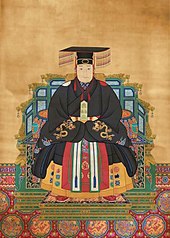
There were many problems—fiscal or other—facing Ming China that started during the reign of theWanli Emperor(1572–1620). In the beginning of his reign, Wanli surrounded himself with able advisors and made a conscientious effort to handle state affairs. His Grand SecretaryZhang Juzheng(1572–82) built up an effective network of alliances with senior officials. However, there was no one after him skilled enough to maintain the stability of these alliances;[63]officials soon banded together in opposing political factions. Over time Wanli grew tired of court affairs and frequent political quarreling amongst his ministers, preferring to stay behind the walls of the Forbidden City and out of his officials' sight.[64]Scholar-officials lost prominence in administration as eunuchs became intermediaries between the aloof emperor and his officials; any senior official who wanted to discuss state matters had to persuade powerful eunuchs with a bribe simply to have his demands or message relayed to the emperor.[65]There were several military campaigns, which included theOrdos campaign,Bozhou rebellionby theChiefdom of Bozhouin southwestern China and theImjin War,during the Wanli Emperor's reign.[66][67][68][69][70]
Role of eunuchs
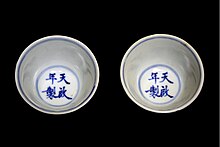
The Hongwu Emperor forbade eunuchs to learn how to read or engage in politics. Whether or not these restrictions were carried out with absolute success in his reign, eunuchs during the Yongle Emperor's reign (1402–1424) and afterwards managed huge imperial workshops, commanded armies, and participated in matters of appointment and promotion of officials. Yongle put 75 eunuchs in charge of foreign policy; they traveled frequently to vassal states including Annam, Mongolia, the Ryukyu Islands, and Tibet and less frequently to farther-flung places like Japan and Nepal. In the later 15th century, however, eunuch envoys generally only traveled to Korea.[71]
The eunuchs developed their own bureaucracy that was organized parallel to but was not subject to the civil service bureaucracy.[72]Although there were several dictatorial eunuchs throughout the Ming, such asWang Zhen,Wang Zhi, andLiu Jin,excessive tyrannical eunuch power did not become evident until the 1590s when theWanli Emperorincreased their rights over the civil bureaucracy and granted them power to collect provincial taxes.[65][73]
The eunuchWei Zhongxian(1568–1627) dominated the court of theTianqi Emperor(r. 1620–1627) and had his political rivals tortured to death, mostly the vocal critics from the faction of theDonglin Society.He ordered temples built in his honor throughout the Ming Empire, and built personal palaces created with funds allocated for building the previous emperor's tombs. His friends and family gained important positions without qualifications. Wei also published a historical work lambasting and belittling his political opponents.[74]The instability at court came right as natural calamity, pestilence, rebellion, and foreign invasion came to a peak. TheChongzhen Emperor(r. 1627–44) had Wei dismissed from court, which led to Wei's suicide shortly after.
The eunuchs built their own social structure, providing and gaining support to their birth clans. Instead of fathers promoting sons, it was a matter of uncles promoting nephews. The Heishanhui Society in Peking sponsored the temple that conducted rituals for worshiping the memory of Gang Tie, a powerful eunuch of the Yuan dynasty. The Temple became an influential base for highly placed eunuchs, and continued in a somewhat diminished role during the Qing dynasty.[75][76][77]
Economic breakdown and natural disasters

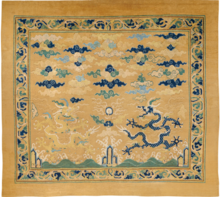
During the last years of the Wanli era and those of his two successors, an economic crisis developed that was centered on a sudden widespread lack of the empire's chief medium of exchange: silver.The Portuguesefirstestablished trade with Chinain 1516.[78]Following the Ming Emperor's decision to ban direct trade with Japan, Portuguese traders acted as an intermediary between China and Japan by buying Chinese silks from China and selling it to Japan for silver.[79]After someinitial hostilitiesgained consent from the Ming court in 1557 to settleMacauas their permanent trade base in China.[80]Their role in providing silver was gradually surpassed bythe Spanish,[81][82][83]while eventhe Dutchchallenged them for control of this trade.[84][85]Philip IV of Spain(r. 1621–1665) began cracking down on illegal smuggling of silver fromNew SpainandPeruacross thePacificthrough thePhilippinestowards China, in favor ofshipping silver mined in the Spanish Latin American coloniesthrough Spanish ports. People began hoarding precious silver as there was progressively less of it, forcing the ratio of the value of copper to silver into a steep decline. In the 1630s a string of one thousandcopper coinsequaled an ounce of silver; by 1640 that sum could fetch half an ounce; and, by 1643 only one-third of an ounce.[81]For peasants this meant economic disaster, since they paid taxes in silver while conducting local trade and crop sales in copper.[86]Historians have debated the validity of the theory that silver shortages caused the downfall of the Ming dynasty.[87][88]
Famines became common in northern China in the early 17th century because of unusually dry and cold weather that shortened the growing season—effects of a larger ecological event now known as theLittle Ice Age.[89]Famine, alongside tax increases, widespread military desertions, a declining relief system, and natural disasters such as flooding and inability of the government to properly manage irrigation and flood-control projects caused widespread loss of life and normal civility.[89]The central government, starved of resources, could do very little to mitigate the effects of these calamities. Making matters worse, a widespread epidemic, theGreat Plague of 1633–1644,spread across China from Zhejiang to Henan, killing an unknown but large number of people.[90]The deadliest earthquake of all time, theShaanxi earthquake of 1556,occurred during theJiajing Emperor's reign, killing approximately 830,000 people.[91]
Fall of the Ming
Rise of the Manchus

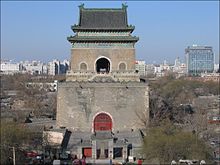
Originally a Ming vassal who officially considered himself a guardian of the Ming border and a local representative of imperial Ming power,[92]Nurhaci,leader of theJianzhou Jurchens,unified other Jurchen clansto create a new Manchu ethnic identity. He offered to lead his armies to support Ming andJoseonarmies against theJapanese invasions of Koreain the 1590s. Ming officials declined the offer, but granted him the title of dragon-tiger general for his gesture. Recognizing the weakness of Ming authority in Manchuria at the time, he consolidated power by co-opting or conquering surrounding territories. In 1616 he declared himselfKhanand established theLater Jin dynastyin reference to theprevious Jurchen-ruled Jin dynasty.In 1618 he openly renounced the Ming overlordship and effectively declared war against the Ming with the "Seven Grievances."[93]
In 1636, Nurhaci's sonHong Taijirenamed his dynasty the "Great Qing"atMukden(modern Shenyang), which had been made their capital in 1625.[94][95]Hong Taiji also adopted the Chinese imperial titlehuangdi,declared theChongde( "Revering Virtue" ) era, and changed the ethnic name of his people from "Jurchen" to "Manchu".[95][96]In 1636, Banner Armies defeated Joseon during theSecond Manchu invasion of Koreaand forced Joseon to become a Qing tributary. Shortly after, the Koreans renounced their long-held loyalty to the Ming dynasty.[96]
Rebellion, invasion, collapse
A peasant soldier namedLi Zichengmutinied with his fellow soldiers in western Shaanxi in the early 1630s after the Ming government failed to ship much-needed supplies there.[89]In 1634 he was captured by a Ming general and released only on the terms that he return to service.[97]The agreement soon broke down when a local magistrate had thirty-six of his fellow rebels executed; Li's troops retaliated by killing the officials and continued to lead a rebellion based in Rongyang, centralHenanprovince by 1635.[98]By the 1640s, an ex-soldier and rival to Li—Zhang Xianzhong(1606–1647)—had created a firm rebel base inChengdu,Sichuan,with the establishment of theXi dynasty,while Li's center of power was inHubeiwith extended influence over Shaanxi and Henan.[98]
In 1640, masses of Chinese peasants who were starving, unable to pay their taxes, and no longer in fear of the frequently defeated Chinese army, began to form into huge bands of rebels. The Chinese military, caught between fruitless efforts to defeat the Manchu raiders from the north and huge peasant revolts in the provinces, essentially fell apart. Unpaid and unfed, the army was defeated by Li Zicheng—now self-styled as the Prince ofShun—and deserted the capital without much of a fight. On 25 April 1644, Beijing fell to a rebel army led by Li Zicheng when the city gates were opened by rebel allies from within. During the turmoil,Chongzhen,the last Ming emperor, accompanied only by a eunuch servant, hanged himselfon a tree in the imperial gardenright outside the Forbidden City.[99]
Seizing opportunity, theEight Bannerscrossed theGreat Wallafter the Ming border generalWu Sangui(1612–1678) opened the gates atShanhai Pass.This occurred shortly after he learned about the fate of the capital and an army of Li Zicheng marching towards him; weighing his options of alliance, he decided to side with the Manchus.[100]The Eight Banners under the Manchu PrinceDorgon(1612–1650) and Wu Sangui approached Beijing after the army sent by Li was destroyed atShanhaiguan;the Prince of Shun's army fled the capital on the fourth of June. On 6 June, the Manchus and Wu entered the capital and proclaimed the youngShunzhi Emperorruler of China. After being forced out ofXi'anby the Qing, chased along theHan RivertoWuchang,and finally along the northern border ofJiangxiprovince, Li Zicheng died there in the summer of 1645, thus ending theShun dynasty.One report says his death was a suicide; another states that he was beaten to death by peasants after he was caught stealing their food.[101]
Despite the loss of Beijing and the death of the emperor, the Ming were not yet totally destroyed. Nanjing, Fujian, Guangdong, Shanxi, and Yunnan were all strongholds of Ming resistance. However, there were several pretenders for the Ming throne, and their forces were divided. These scattered Ming remnants in southern China after 1644 were collectively designated by 19th-century historians as theSouthern Ming.[102]Each bastion of resistance was individually defeated by the Qing until 1662, when the last Southern Ming emperor,Zhu Youlang,the Yongli Emperor, was captured and executed.[e]Despite the Ming defeat, smaller loyalist movements continued until the proclamation of theRepublic of China.
Government
Province, prefecture, sub-prefecture and county

Described as "one of the greatest eras of orderly government and social stability in human history" byEdwin O. Reischauer,John K. FairbankandAlbert M. Craig,[105]the Ming emperors took over the provincial administration system of the Yuan dynasty, and the thirteen Ming provinces are the precursors of the modern provinces. Throughout the Song dynasty, the largest political division was thecircuit(luLộ ).[106]However, after theJurchen invasionin 1127, the Song court established four semi-autonomous regional command systems based on territorial and military units, with a detached service secretariat that would become the provincial administrations of the Yuan, Ming, and Qing dynasties.[107]Copied on the Yuan model, the Ming provincial bureaucracy contained three commissions: one civil, one military, and one for surveillance. Below the level of theprovince(shengTỉnh ) wereprefectures(fuPhủ ) operating under a prefect (zhifuTri phủ ), followed bysubprefectures(zhouChâu ) under a subprefect. The lowest unit was thecounty(xianHuyện ), overseen by a magistrate. Besides the provinces, there were also two large areas that belonged to no province, but were metropolitan areas (jingKinh ) attached to Nanjing and Beijing.[108]
Institutions and bureaus
Institutional trends
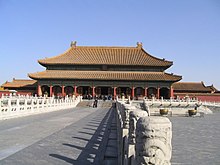
Departing from the main central administrative system generally known as theThree Departments and Six Ministriessystem,which was instituted by various dynastiessince lateHan(202 BCE – 220 CE), the Ming administration had only one department, the Secretariat, that controlled the six ministries. Following the execution of theChancellorHu Weiyong in 1380, the Hongwu Emperor abolished the Secretariat, theCensorate,and the Chief Military Commission and personally took charge of the Six Ministries and the regional Five Military Commissions.[109][110]Thus a whole level of administration was cut out and only partially rebuilt by subsequent rulers.[109]TheGrand Secretariat,at the beginning a secretarial institution that assisted the emperor with administrative paperwork, was instituted, but without employing grand counselors, orchancellors.
The Hongwu Emperor sent his heir apparent to Shaanxi in 1391 to "tour and soothe" (xunfu) the region; in 1421 the Yongle Emperor commissioned 26 officials to travel the empire and uphold similar investigatory and patrimonial duties. By 1430 thesexunfuassignments became institutionalized as "grand coordinators".Hence, the Censorate was reinstalled and first staffed with investigating censors, later with censors-in-chief. By 1453, the grand coordinators were granted the title vice censor-in-chief or assistant censor-in-chief and were allowed direct access to the emperor.[111]As in prior dynasties, the provincial administrations were monitored by a travelling inspector from the Censorate. Censors had the power to impeach officials on an irregular basis, unlike the senior officials who were to do so only in triennial evaluations of junior officials.[111][112]
Although decentralization of state power within the provinces occurred in the early Ming, the trend of central government officials delegated to the provinces as virtual provincial governors began in the 1420s. By the late Ming dynasty, there were central government officials delegated to two or more provinces as supreme commanders and viceroys, a system which reined in the power and influence of the military by the civil establishment.[113]
Grand Secretariat and Six Ministries
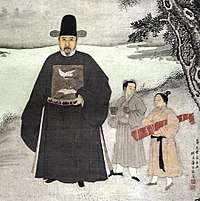
Governmental institutions in China conformed to a similar pattern for some two thousand years, but each dynasty installed special offices and bureaus, reflecting its own particular interests. The Ming administration utilizedGrand Secretariesto assist the emperor, handling paperwork under the reign of theYongle Emperorand later appointed as top officials of agencies and Grand Preceptor, a top-ranking, non-functional civil service post, under theHongxi Emperor(r. 1424–25).[114]The Grand Secretariat drew its members from theHanlin Academyand were considered part of the imperial authority, not the ministerial one (hence being at odds with both the emperor and ministers at times).[115]The Secretariat operated as a coordinating agency, whereas the Six Ministries—Personnel,Revenue,Rites,War,Justice,andPublic Works—were direct administrative organs of the state:[116]
- TheMinistry of Personnelwas in charge of appointments, merit ratings, promotions, and demotions of officials, as well as granting of honorific titles.[117]
- TheMinistry of Revenuewas in charge of gathering census data, collecting taxes, and handling state revenues, while there were two offices of currency that were subordinate to it.[118]
- TheMinistry of Riteswas in charge of state ceremonies, rituals, and sacrifices; it also oversaw registers for Buddhist and Daoist priesthoods and even the reception of envoys from tributary states.[119]
- TheMinistry of Warwas in charge of the appointments, promotions, and demotions of military officers, the maintenance of military installations, equipment, and weapons, as well as the courier system.[120]
- TheMinistry of Justicewas in charge of judicial and penal processes, but had no supervisory role over the Censorate or the Grand Court of Revision.[121]
- TheMinistry of Public Workshad charge of government construction projects, hiring of artisans and laborers for temporary service, manufacturing government equipment, the maintenance of roads and canals, standardization of weights and measures, and the gathering of resources from the countryside.[121]
Bureaus and offices for the imperial household

The imperial household was staffed almost entirely by eunuchs and ladies with their own bureaus.[122]Female servants were organized into the Bureau of Palace Attendance, Bureau of Ceremonies, Bureau of Apparel, Bureau of Foodstuffs, Bureau of the Bedchamber, Bureau of Handicrafts, and Office of Staff Surveillance.[122]Starting in the 1420s, eunuchs began taking over these ladies' positions until only the Bureau of Apparel with its four subsidiary offices remained.[122]Hongwu had his eunuchs organized into the Directorate of Palace Attendants, but as eunuch power at court increased, so did their administrative offices, with eventual twelve directorates, four offices, and eight bureaus.[122]The dynasty had a vast imperial household, staffed with thousands of eunuchs, who were headed by the Directorate of Palace Attendants. The eunuchs were divided into different directorates in charge of staff surveillance, ceremonial rites, food, utensils, documents, stables, seals, apparel, and so on.[123]The offices were in charge of providing fuel, music, paper, and baths.[123]The bureaus were in charge of weapons, silverwork, laundering, headgear, bronze work, textile manufacture, wineries, and gardens.[123]At times, the most influential eunuch in the Directorate of Ceremonial acted as ade factodictator over the state.[124]
Although the imperial household was staffed mostly by eunuchs and palace ladies, there was a civil service office called the Seal Office, which cooperated with eunuch agencies in maintaining imperial seals, tallies, and stamps.[125]There were also civil service offices to oversee the affairs of imperial princes.[126]
Personnel
Scholar-officials
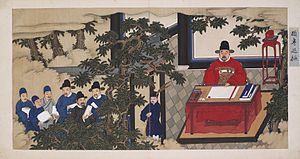
The Hongwu emperor from 1373 to 1384 staffed his bureaus with officials gathered through recommendations only. After that the scholar-officials who populated the many ranks of bureaucracy were recruited through a rigorousexamination systemthat was initially established by theSui dynasty(581–618).[127][128][129]Theoretically the system of exams allowed anyone to join the ranks of imperial officials (although it was frowned upon for merchants to join); in reality the time and funding needed to support the study in preparation for the exam generally limited participants to those already coming from the landholding class. However, the government did exact provincial quotas while drafting officials. This was an effort to curb monopolization of power by landholding gentry who came from the most prosperous regions, where education was the most advanced. The expansion of theprinting industry since Song timesenhanced the spread of knowledge and number of potential exam candidates throughout the provinces. For young schoolchildren there were printed multiplication tables and primers for elementary vocabulary; for adult examination candidates there were mass-produced, inexpensive volumes of Confucian classics and successful examination answers.[130]

As in earlier periods, the focus of the examination was classical Confucian texts, while the bulk of test material centered on theFour Booksoutlined byZhu Xiin the 12th century.[132]Ming era examinations were perhaps more difficult to pass since the 1487 requirement of completing the "eight-legged essay",a departure from basing essays off progressing literary trends. The exams increased in difficulty as the student progressed from the local level, and appropriate titles were accordingly awarded successful applicants. Officials were classified in nine hierarchic grades, each grade divided into two degrees, with ranging salaries (nominally paid in piculs of rice) according to their rank. While provincial graduates who were appointed to office were immediately assigned to low-ranking posts like the county graduates, those who passed the palace examination were awarded ajinshi('presented scholar') degree and assured a high-level position.[133]In 276 years of Ming rule and ninety palace examinations, the number of doctoral degrees granted by passing the palace examinations was 24,874.[134]Ebrey states that "there were only two to four thousand of thesejinshiat any given time, on the order of one out of 10,000 adult males. "This was in comparison to the 100,000shengyuan('government students'), the lowest tier of graduates, by the 16th century.[135]
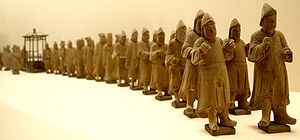
The maximum tenure in office was nine years, but every three years officials were graded on their performance by senior officials. If they were graded as superior then they were promoted, if graded adequate then they retained their ranks, and if graded inadequate they were demoted one rank. In extreme cases, officials would be dismissed or punished. Only capital officials of grade 4 and above were exempt from the scrutiny of recorded evaluation, although they were expected to confess any of their faults. There were over 4,000 school instructors in county and prefectural schools who were subject to evaluations every nine years. The Chief Instructor on the prefectural level was classified as equal to a second-grade county graduate. The Supervisorate of Imperial Instruction oversaw the education of the heir apparent to the throne; this office was headed by a Grand Supervisor of Instruction, who was ranked as first class of grade three.[136]
Historians debate whether the examination system expanded or contracted upward social mobility. On the one hand, the exams were graded without regard to a candidate's social background, and were theoretically open to everyone.[f]In actual practice, the successful candidates had years of a very expensive, sophisticated tutoring of the sort that wealthy gentry families specialized in providing their talented sons. In practice, 90 percent of the population was ineligible due to lack of education, but the upper 10 percent had equal chances for moving to the top. To be successful young men had to have extensive, expensive training in classical Chinese, the use of Mandarin in spoken conversation, calligraphy, and had to master the intricate poetic requirements of the eight-legged essay. Not only did the traditional gentry dominated the system, they also learned that conservatism and resistance to new ideas was the path to success. For centuries critics had pointed out these problems, but the examination system only became more abstract and less relevant to the needs of China.[137]The consensus of scholars is that the eight-legged essay can be blamed as a major cause of "China's cultural stagnation and economic backwardness." However Benjamin Ellman argues there were some positive features, since the essay form was capable of fostering "abstract thinking, persuasiveness, and prosodic form" and that its elaborate structure discouraged a wandering, unfocused narrative ".[138]
Lesser functionaries

Scholar-officials who entered civil service through examinations acted as executive officials to a much larger body of non-ranked personnel called lesser functionaries. They outnumbered officials by four to one; Charles Hucker estimates that they were perhaps as many as 100,000 throughout the empire. These lesser functionaries performed clerical and technical tasks for government agencies. Yet they should not be confused with lowly lictors, runners, and bearers; lesser functionaries were given periodic merit evaluations like officials and after nine years of service might be accepted into a low civil service rank.[139]The one great advantage of the lesser functionaries over officials was that officials were periodically rotated and assigned to different regional posts and had to rely on the good service and cooperation of the local lesser functionaries.[140]
Eunuchs, princes, and generals

Eunuchs gained unprecedented power over state affairs during the Ming dynasty. One of the most effective means of control was the secret service stationed in what was called the Eastern Depot at the beginning of the dynasty, later the Western Depot. This secret service was overseen by the Directorate of Ceremonial, hence this state organ's often totalitarian affiliation. Eunuchs had ranks that were equivalent to civil service ranks, only theirs had four grades instead of nine.[141][142]
Descendants of the first Ming emperor were made princes and given (typically nominal) military commands, annual stipends, and large estates. The title used was "king" (Vương,wáng) but—unlike the princes in theHanandJindynasties—these estates were notfeudatories,the princes did not serve any administrative function, and they partook in military affairs only during the reigns of the first two emperors.[143]Therebellion of the Prince of Yanwas justified in part as upholding the rights of the princes, but once theYongle Emperorwas enthroned, he continued his nephew's policy of disarming his brothers and moved their fiefs away from the militarized northern border. Although princes served no organ of state administration, the princes, consorts of the imperial princesses, and ennobled relatives did staff theImperial Clan Court,which supervised the imperial genealogy.[126]
Like scholar-officials, military generals were ranked in a hierarchic grading system and were given merit evaluations every five years (as opposed to three years for officials).[144]However, military officers had less prestige than officials. This was due to their hereditary service (instead of solely merit-based) and Confucian values that dictated those who chose the profession of violence (wu) over the cultured pursuits of knowledge (wen).[145]Although seen as less prestigious, military officers were not excluded from taking civil service examinations, and after 1478 the military even held their own examinations to test military skills.[146]In addition to taking over the established bureaucratic structure from the Yuan period, the Ming emperors established the new post of the travelling military inspector. In the early half of the dynasty, men of noble lineage dominated the higher ranks of military office; this trend was reversed during the latter half of the dynasty as men from more humble origins eventually displaced them.[147]
Society and culture
Literature and arts

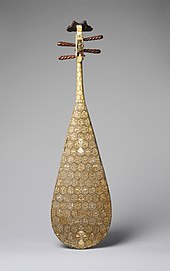
Literature,painting,poetry,music,andChinese operaof various types flourished during the Ming dynasty, especially in the economically prosperous lower Yangzi valley. Although short fiction had been popular as far back as the Tang dynasty (618–907),[148]and the works of contemporaneous authors such as Xu Guangqi, Xu Xiake, and Song Yingxing were often technical and encyclopedic, the most striking literary development was the vernacular novel. While the gentry elite were educated enough to fully comprehend the language ofClassical Chinese,those with rudimentary education—such as women in educated families, merchants, and shop clerks—became a large potential audience for literature and performing arts that employedVernacular Chinese.[149]Literati scholars edited or developedmajor Chinese novelsinto mature form in this period, such asWater MarginandJourney to the West.Jin Ping Mei,published in 1610, although incorporating earlier material, marks the trend toward independent composition and concern with psychology.[150]In the later years of the dynasty,Feng MenglongandLing Mengchuinnovated with vernacular short fiction. Theater scripts were equally imaginative. The most famous,The Peony Pavilion,was written byTang Xianzu(1550–1616), with its first performance at thePavilion of Prince Tengin 1598.
Informal essay and travel writing was another highlight.Xu Xiake(1587–1641), atravel literatureauthor, published hisTravel Diariesin 404,000 writtencharacters,with information on everything from localgeographytomineralogy.[151][152]The first reference to the publishing of private newspapers in Beijing was in 1582; by 1638 thePeking Gazetteswitched from usingwoodblock printtomovable typeprinting.[153]The new literary field of the moral guide to business ethics was developed during the late Ming period, for the readership of the merchant class.[154]
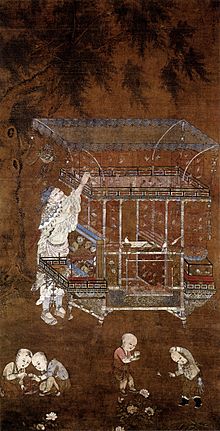
In contrast to Xu Xiake, who focused on technical aspects in his travel literature, the Chinese poet and officialYuan Hongdao(1568–1610) used travel literature to express his desires for individualism as well as autonomy from and frustration with Confucian court politics.[155]Yuan desired to free himself from the ethical compromises that were inseparable from the career of a scholar-official. This anti-official sentiment in Yuan's travel literature and poetry was actually following in the tradition of the Song dynasty poet and officialSu Shi(1037–1101).[156]Yuan Hongdao and his two brothers, Yuan Zongdao (1560–1600) andYuan Zhongdao(1570–1623), were the founders of the Gong'an School of letters.[157]This highly individualistic school of poetry and prose was criticized by the Confucian establishment for its association with intense sensual lyricism, which was also apparent in Ming vernacular novels such as theJin Ping Mei.[157]Yet even gentry and scholar-officials were affected by the new popular romantic literature, seeking courtesans as soulmates to re-enact the heroic love stories that arranged marriages often could not provide or accommodate.[158]


Famous painters includedNi ZanandDong Qichang,as well as theFour Masters of the Ming dynasty,Shen Zhou,Tang Yin,Wen Zhengming,andQiu Ying.They drew upon the techniques, styles, and complexity in painting achieved by their Song and Yuan predecessors, but added techniques and styles. Well-known Ming artists could make a living simply by painting due to the high prices they demanded for their artworks and the great demand by the highly cultured community to collect precious works of art. The artist Qiu Ying was once paid 2.8 kg (100 oz) of silver to paint a long handscroll for the eightieth birthday celebration of the mother of a wealthy patron. Renowned artists often gathered an entourage of followers, some who were amateurs who painted while pursuing an official career and others who were full-time painters.[159]

The period was also renowned for ceramics and porcelains. The major production center for porcelain was theimperial kilns at JingdezheninJiangxiprovince, most famous in the period forblue and white porcelain,but also producing other styles. TheDehua porcelain factoriesinFujiancatered to European tastes by creatingChinese export porcelainby the late 16th century. Individual potters also became known, such asHe Chaozong,who became famous in the early 17th century for his style ofwhite porcelainsculpture. InThe Ceramic Trade in Asia,Chuimei Ho estimates that about 16% of late Ming era Chinese ceramic exports were sent to Europe, while the rest were destined for Japan and South East Asia.[160]
Carved designs in lacquerwareand designs glazed ontoporcelainwares displayed intricate scenes similar in complexity to those in painting. These items could be found in the homes of the wealthy, alongside embroidered silks and wares injade,ivory, andcloisonné.The houses of the rich were also furnished with rosewood furniture and featherylatticework.The writing materials in a scholar's private study, including elaborately carved brush holders made of stone or wood, were designed and arranged ritually to give an aesthetic appeal.[161]
Connoisseurship in the late Ming period centered on these items of refined artistic taste, which provided work for art dealers and even underground scammers who themselves made imitations and false attributions.[161]The JesuitMatteo Ricciwhile staying in Nanjing wrote that Chinese scam artists were ingenious at making forgeries and huge profits.[162]However, there were guides to help the wary new connoisseur;Liu Tong(died 1637) wrote a book printed in 1635 that told his readers how to spot fake and authentic pieces of art.[163]He revealed that aXuande era(1426–1435) bronze work could be authenticated by judging its sheen; porcelain wares from the Yongle era (1402–1424) could be judged authentic by their thickness.[164]
Religion
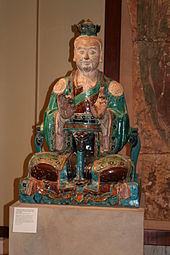
The dominant religious beliefs during the Ming dynasty were the various forms ofChinese folk religionand theThree Teachings—Confucianism,Taoism,andBuddhism.TheYuan-supportedTibetan lamasfell from favor, and the early Ming emperors particularly favored Taoism, granting its practitioners many positions in the state's ritual offices.[165]The Hongwu Emperor curtailed the cosmopolitan culture of the Mongol Yuan dynasty, and the prolific Prince of NingZhu Quaneven composed one encyclopedia attacking Buddhism as a foreign "mourning cult", deleterious to the state, and another encyclopedia that subsequently joined theTaoist canon.[165]
The Yongle Emperor and later emperors strongly patronised Tibetan Buddhism by supporting construction, printing of sutras, ceremonies etc., to seek legitimacy among foreign audiences. Yongle tried to portray himself as a Buddhist ideal king, a cakravartin.[166]There is evidence that this portrayal was successful in persuading foreign audiences.[167]
Islamwas also well-established throughout China, with a history said to have begun withSa'd ibn Abi Waqqasduring the Tang dynastyand strong official supportduring the Yuan.Although the Mingsharply curtailed this support,there were still several prominent Muslim figures early on, including the Yongle Emperor's powerful eunuchZheng He.The Hongwu Emperor's generals Chang Yuqun,Lan Yu,Ding Dexing, andMu Yinghave also been identified as Muslim by Hui scholars, though this is doubted by non-Muslim sources. Regardless, the presence of Muslims in the armies that drove the Mongols northwards caused a gradual shift in the Chinese perception of Muslims, transitioning from "foreigners" to "familiar strangers".[168]The Hongwu Emperor wrotea 100 character praiseof Islam and the prophet Muhammad. The Ming Emperors strongly sponsored the construction of mosques and granted generous liberties for the practice of Islam.[169]
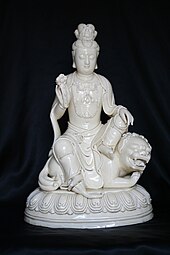
The advent of the Ming was initially devastating to Christianity: in his first year, theHongwu Emperordeclared the eighty-year-oldFranciscanmissions among the Yuan heterodox and illegal.[171]The centuries-oldChurch of the East in Chinaalso disappeared. During the later Ming a new wave of Christian missionaries arrived—particularlyJesuits—who employed new western science and technology in their arguments for conversion. They were educated in Chinese language and culture atSt. Paul's CollegeonMacauafter its founding in 1579. The most influential wasMatteo Ricci,whose "Map of the Myriad Countries of the World"upendedtraditional geographythroughout East Asia, and whose work with the convertXu Guangqiled to the first Chinese translation ofEuclid'sElementsin 1607. The discovery of aXi'an SteleatXi'anin 1625 also permitted Christianity to be treated as an old and established faith, rather than as a new and dangerous cult. However, there were strong disagreements about the extent to which converts could continue to perform rituals to theemperor,Confucius,or theirancestors:Ricci had been very accommodating and an attempt by his successors to backtrack from this policy led to theNanjing Incident of 1616,which exiled four Jesuits toMacauand forced the others out of public life for six years.[172]A series of spectacular failures by theChinese astronomers—including missing an eclipse easily computed by Xu Guangqi andSabatino de Ursis—and a return by the Jesuits to presenting themselves as educated scholars in the Confucian mold[173]restored their fortunes. However, by the end of the Ming theDominicanshad begun theChinese Rites controversyin Rome that would eventually lead to a full ban of Christianity under theQing dynasty.
During his mission, Ricci was also contacted in Beijing by one of the approximately 5,000Kaifeng Jewsand introduced them andtheir long history in Chinato Europe.[174]However, the1642 floodcaused by Kaifeng's Ming governor devastated the community, which lost five of its twelve families, its synagogue, and most of its Torah.[175]
Philosophy
Wang Yangming's Confucianism
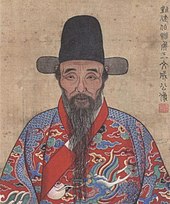
During the Ming dynasty, theNeo-Confuciandoctrines of theSongscholarZhu Xiwere embraced by the court and the Chinese literati at large, although the direct line of his school was destroyed by theYongle Emperor'sextermination of the ten degrees of kinshipofFang Xiaoruin 1402. The Ming scholar most influential upon subsequent generations, however, wasWang Yangming(1472–1529), whose teachings were attacked in his own time for their similarity toChan Buddhism.[176]Building upon Zhu Xi's concept of the "extension of knowledge" (Lý họcorCách vật trí tri), gaining understanding through careful and rational investigation of things and events, Wang argued that universal concepts would appear in the minds of anyone.[177]Therefore, he claimed that anyone—no matter their pedigree or education—could become as wise asConfuciusandMenciushad been and that their writings were not sources of truth but merely guides that might have flaws when carefully examined.[178]A peasant with a great deal of experience and intelligence would then be wiser than an official who had memorized theClassicsbut not experienced the real world.[178]
Conservative reaction
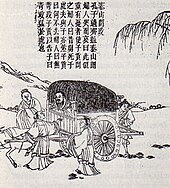
Otherscholar-bureaucratswere wary of Wang's heterodoxy, the increasing number of his disciples while he was still in office, and his overall socially rebellious message. To curb his influence, he was often sent out to deal with military affairs and rebellions far away from the capital. Yet his ideas penetrated mainstream Chinese thought and spurred new interest in Taoism and Buddhism.[176]Furthermore, people began to question the validity of the social hierarchy and the idea that the scholar should be above the farmer. Wang Yangming's disciple and salt-mine worker Wang Gen gave lectures to commoners about pursuing education to improve their lives, while his follower He Xinyin (Hà tâm ẩn) challenged the elevation and emphasis of the family in Chinese society.[176]His contemporaryLi Zhieven taught that women were the intellectual equals of men and should be given a better education; both Li and He eventually died in prison, jailed on charges of spreading "dangerous ideas".[179]Yet these "dangerous ideas" of educating women had long been embraced by some mothers[180]and bycourtesanswho were as literate and skillful in calligraphy, painting, and poetry as their male guests.[181]
The liberal views of Wang Yangming were opposed by theCensorateand by theDonglin Academy,re-established in 1604. These conservatives wanted a revival of orthodox Confucian ethics. Conservatives such as Gu Xiancheng (1550–1612) argued against Wang's idea of innate moral knowledge, stating that this was simply a legitimization for unscrupulous behavior such as greedy pursuits and personal gain. These two strands of Confucian thought, hardened by Chinese scholars' notions of obligation towards their mentors, developed into pervasive factionalism among the ministers of state, who used any opportunity to impeach members of the other faction from court.[182]
Urban and rural life
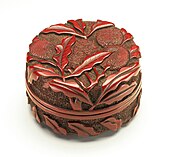
Wang Gen was able to give philosophical lectures to many commoners from different regions because—following the trend already apparent in the Song dynasty—communities in Ming society were becoming less isolated as the distance between market towns was shrinking. Schools, descent groups, religious associations, and other local voluntary organizations were increasing in number and allowing more contact between educated men and local villagers.[183]Jonathan Spencewrites that the distinction between what was town and country was blurred in Ming China, since suburban areas with farms were located just outside and in some cases within the walls of a city. Not only was the blurring of town and country evident, but also of socioeconomic class in the traditional four occupations (Shì nóng gōng shāng,Sĩ nông công thương), since artisans sometimes worked on farms in peak periods, and farmers often traveled into the city to find work during times of dearth.[184]
A variety of occupations could be chosen or inherited from a father's line of work. This would include – but was not limited to – coffin makers, ironworkers and blacksmiths, tailors, cooks and noodle-makers, retail merchants, tavern, teahouse, or winehouse managers, shoemakers, seal cutters, pawnshop owners, brothel heads, and merchant bankers engaging in a proto-banking system involving notes of exchange.[81][185]Virtually every town had abrothelwhere female and male prostitutes could be had.[186]Male catamites fetched a higher price than female concubines sincepederastywith a teenage boy was seen as a mark of elite status, regardless ofsodomybeing repugnant to sexual norms.[187]Public bathingbecame much more common than in earlier periods.[188]Urban shops and retailers sold a variety of goods such asspecial paper moneyto burn at ancestral sacrifices, specialized luxury goods, headgear, fine cloth, teas, and others.[185]Smaller communities and townships too poor or scattered to support shops and artisans obtained their goods from periodic market fairs and traveling peddlers. A small township also provided a place for simple schooling, news and gossip, matchmaking, religious festivals, traveling theater groups, tax collection, and bases of famine relief distribution.[184]
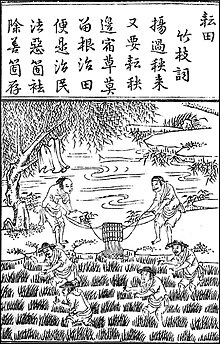
Farming villagers in the north spent their days harvesting crops like wheat and millet, while farmers south of theHuai Riverengaged in intensive rice cultivation and had lakes and ponds where ducks and fish could be raised. The cultivation of mulberry trees for silkworms and tea bushes could be found mostly south of theYangzi River;even further southsugarcaneand citrus were grown as basic crops.[184]Some people in the mountainous southwest made a living by selling lumber from hard bamboo. Besides cutting down trees to sell wood, the poor also made a living by turning wood into charcoal, and by burningoystershells to makelimeand fired pots, and weaving mats and baskets.[189]In the north traveling by horse and carriage was most common, while in the south the myriad of rivers, canals, and lakes provided cheap and easy water transport. Although the south had the characteristic of the wealthy landlord and tenant farmers, there were on average many more owner-cultivators north of the Huai River due to harsher climate, living not far above subsistence level.[190]
Early Ming dynasty saw the strictestsumptuary lawsin Chinese history. It was illegal for commoners to wear fine silk or dress in bright red, dark green or yellow colors; nor could they wear boots orguanhats. Women could not use ornaments made from gold, jade, pearl or emerald. Merchants and their families were further banned from using silk. However, these laws were no longer enforced from the middle Ming period onwards.[191]
Science and technology

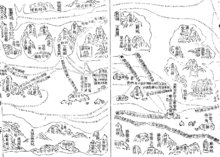
After the flourishing ofscience and technology in the Song dynasty,the Ming dynasty perhaps saw fewer advancements in science and technology compared to the pace of discovery in theWestern world.In fact, key advances in Chinese science in the late Ming were spurred by contact with Europe. In 1626Johann Adam Schall von Bellwrote the first Chinese treatise on thetelescope,theYuanjingshuo(Far Seeing Optic Glass); in 1634 theChongzhen Emperoracquired the telescope of the lateJohann Schreck(1576–1630).[192]Theheliocentricmodel of the solar system was rejected by the Catholic missionaries in China, butJohannes KeplerandGalileo Galilei's ideas slowly trickled into China starting with the Polish JesuitMichael Boym(1612–1659) in 1627, Adam Schall von Bell's treatise in 1640, and finallyJoseph Edkins,Alex Wylie,andJohn Fryerin the 19th century.[193]Catholic Jesuits in China would promoteCopernicantheory at court, yet at the same time embrace thePtolemaicsystem in their writing; it was not until 1865 that Catholic missionaries in China sponsored the heliocentric model as their Protestant peers did.[194]AlthoughShen Kuo(1031–1095) andGuo Shoujing(1231–1316) had laid the basis fortrigonometryin China, another important work in Chinese trigonometry would not be published again until 1607 with the efforts of Xu Guangqi and Matteo Ricci.[195]Ironically, some inventions which had their origins in ancient China were reintroduced to China from Europe during the late Ming; for example, thefield mill.[196]
By the 16th century theChinese calendarwas in need of reform. Although the Ming had adoptedGuo Shoujing'sShoushicalendar of 1281, which was just as accurate as theGregorian calendar,the Ming Directorate of Astronomy failed to periodically readjust it;[clarification needed]this was perhaps due to their lack of expertise since their offices had become hereditary in the Ming and the Statutes of the Ming prohibited private involvement in astronomy.[197][198]A sixth-generation descendant of the Hongxi Emperor, the "Prince"Zhu Zaiyu(1536–1611), submitted a proposal to fix the calendar in 1595, but the ultra-conservative astronomical commission rejected it.[199][198]This was the same Zhu Zaiyu who discovered the system of tuning known asequal temperament,a discovery made simultaneously bySimon Stevin(1548–1620) in Europe.[200]In addition to publishing his works on music, he was able to publish his findings on the calendar in 1597.[198]A year earlier, the memorial of Xing Yunlu suggesting a calendar improvement was rejected by the Supervisor of the Astronomical Bureau due to the law banning private practice of astronomy; Xing would later serve with Xu Guangqi in reforming the calendar (Chinese:Sùng trinh lịch thư) in 1629 according to Western standards.[198]
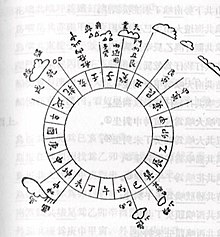
When the Ming founder Hongwu came upon the mechanical devices housed in the Yuan dynasty's palace at Khanbaliq—such as fountains with balls dancing on their jets,self-operating tiger automata,dragon-headed devices that spouted mists of perfume, andmechanical clocksin the tradition ofYi Xing(683–727) andSu Song(1020–1101)—he associated all of them with the decadence of Mongol rule and had them destroyed.[201]This was described in full length by the Divisional Director of the Ministry of Works, Xiao Xun, who also carefully preserved details on the architecture and layout of the Yuan dynasty palace.[201]Later, European Jesuits such as Matteo Ricci andNicolas Trigaultwould briefly mention indigenous Chinese clockworks that featured drive wheels.[202]However, both Ricci and Trigault were quick to point out that 16th-century European clockworks were far more advanced than the common time keeping devices in China, which they listed aswater clocks,incense clocks,and "other instruments... with wheels rotated by sand as if by water" (Chinese:Sa lậu).[203]Chinese records—namely theYuan Shi—describe the 'five-wheeled sand clock', a mechanism pioneered by Zhan Xiyuan (fl.1360–80) which featured the scoop wheel of Su Song's earlierastronomical clockand astationary dial faceover which a pointer circulated, similar to European models of the time.[204]This sand-driven wheel clock was improved upon by Zhou Shuxue (fl. 1530–58) who added a fourth large gear wheel, changed gear ratios, and widened the orifice for collecting sand grains since he criticized the earlier model for clogging up too often.[205]

The Chinese were intrigued with European technology, but so were visiting Europeans of Chinese technology. In 1584,Abraham Ortelius(1527–1598) featured in his atlasTheatrum Orbis Terrarumthe peculiar Chinese innovation ofmounting masts and sails onto carriages,just likeChinese ships.[206]Gonzales de Mendozaalso mentioned this a year later—noting even the designs of them on Chinese silken robes—whileGerardus Mercator(1512–1594) featured them in his atlas,John Milton(1608–1674) in one of his famous poems, andAndreas Everardus van Braam Houckgeest(1739–1801) in the writings of his travel diary in China.[207] The encyclopedistSong Yingxing(1587–1666) documented a wide array of technologies, metallurgic and industrial processes in hisTiangong Kaiwuencyclopedia of 1637. This includes mechanical and hydraulic powered devices for agriculture and irrigation,[208]nautical technology such as vessel types andsnorkelinggear for pearl divers,[209][210][211]the annual processes ofsericultureand weaving with theloom,[212]metallurgic processes such as thecrucibletechnique andquenching,[213]manufacturing processes such as for roasting ironpyritein converting sulphide to oxide insulfurused in gunpowder compositions—illustrating how ore was piled up with coal briquettes in an earthen furnace with a still-head that sent over sulfur as vapor that would solidify andcrystallize[214]—and the use of gunpowder weapons such as anaval mineignited by use of a rip-cord andsteel flint wheel.[215]
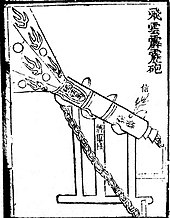
Focusing on agriculture in hisNongzheng Quanshu,the agronomistXu Guangqi(1562–1633) took an interest in irrigation, fertilizers, famine relief, economic and textile crops, and empirical observation of the elements that gave insight into early understandings of chemistry.[216]
There were many advances and new designs in gunpowder weapons during the beginning of the dynasty, but by the mid to late Ming the Chinese began to frequently employ European-style artillery and firearms.[217]TheHuolongjing,compiled byJiao YuandLiu Bowensometime before the latter's death on 16 May 1375 (with a preface added by Jiao in 1412),[218]featured many types of cutting-edge gunpowder weaponry for the time. This includes hollow, gunpowder-filledexploding cannonballs,[219]land minesthat used a complex trigger mechanism of falling weights, pins, and a steel wheellock to ignite the train of fuses,[220]naval mines,[221]fin-mounted winged rockets foraerodynamiccontrol,[222]multistage rocketspropelled bybooster rocketsbefore igniting a swarm of smaller rockets issuing forth from the end of the missile (shaped like a dragon's head),[223]andhand cannonsthat had up toten barrels.[224]
Li Shizhen(1518–1593)—one of the most renownedpharmacologistsand physiciansin Chinese history—belonged to the late Ming period. HisBencao Gangmuis a medical text with 1,892 entries, each entry with its own name called agang.Themuin the title refers to the synonyms of each name.[225]Inoculation, although it can be traced to earlier Chinese folk medicine, was detailed in Chinese texts by the sixteenth century. Throughout the Ming dynasty, around fifty texts were published on the treatment of smallpox.[226]In regards tooral hygiene,theancient Egyptianshad a primitive toothbrush of a twig frayed at the end, but the Chinese were the first to invent the modernbristle toothbrushin 1498, although it used stiff pig hair.[227]
Population
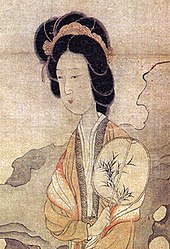
Sinologist historiansdebate the population figures for each era in the Ming dynasty. The historianTimothy Brooknotes that the Ming government census figures are dubious since fiscal obligations prompted many families to underreport the number of people in their households and many county officials to underreport the number of households in their jurisdiction.[228]Children were often underreported, especially female children, as shown by skewed population statistics throughout the Ming.[229]Even adult women were underreported;[230]for example, the Daming Prefecture inNorth Zhilireported a population of 378,167 males and 226,982 females in 1502.[231]The government attempted to revise the census figures using estimates of the expected average number of people in each household, but this did not solve the widespread problem of tax registration.[232]Some part of the gender imbalance may be attributed to the practice of femaleinfanticide.The practice is well documented in China, going back over two thousand years, and it was described as "rampant" and "practiced by almost every family" by contemporary authors.[233]However, the dramatically skewed sex ratios, which many counties reported exceeding 2:1 by 1586, cannot likely be explained by infanticide alone.[230]
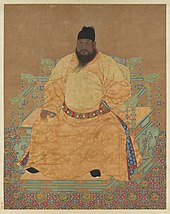
The number of people counted in the census of 1381 was 59,873,305; however, this number dropped significantly when the government found that some 3 million people were missing from the tax census of 1391.[235]Even though underreporting figures was made a capital crime in 1381, the need for survival pushed many to abandon the tax registration and wander from their region, where Hongwu had attempted to impose rigid immobility on the populace. The government tried to mitigate this by creating their own conservative estimate of 60,545,812 people in 1393.[234]In hisStudies on the Population of China,Ho Ping-ti suggests revising the 1393 census to 65 million people, noting that large areas of North China and frontier areas were not counted in that census.[3]Brook states that the population figures gathered in the official censuses after 1393 ranged between 51 and 62 million, while the population was in fact increasing.[234]Even theHongzhi Emperor(r. 1487–1505) remarked that the daily increase in subjects coincided with the daily dwindling amount of registered civilians and soldiers.[189]William Atwell states that around 1400 the population of China was perhaps 90 million people, citing Heijdra and Mote.[236]
Historians are now turning to localgazetteersof Ming China for clues that would show consistent growth in population.[229]Using the gazetteers, Brook estimates that the overall population under theChenghua Emperor(r. 1464–87) was roughly 75 million,[232]despite mid-Ming census figures hovering around 62 million.[189]While prefectures across the empire in the mid-Ming period were reporting either a drop in or stagnant population size, local gazetteers reported massive amounts of incoming vagrant workers with not enough good cultivated land for them to till, so that many would become drifters, conmen, or wood-cutters that contributed to deforestation.[237]TheHongzhiandZhengdeemperors lessened the penalties against those who had fled their home region, while theJiajing Emperor(r. 1521–67) finally had officials register migrants wherever they had moved or fled in order to bring in more revenues.[231]
Even with the Jiajing reforms to document migrant workers and merchants, by the late Ming era the government census still did not accurately reflect the enormous growth in population. Gazetteers across the empire noted this and made their own estimations of the overall population in the Ming, some guessing that it had doubled, tripled, or even grown fivefold since 1368.[238]Fairbank estimates that the population was perhaps 160 million in the late Ming dynasty,[239]while Brook estimates 175 million,[238]and Ebrey states perhaps as large as 200 million.[240]However,a great epidemicthat started in Shanxi Province in 1633, ravaged the densely populated areas along theGrand Canal;a gazetteer in northernZhejiangnoted more than half the population fell ill that year and that 90% of the local populace in one area was dead by 1642.[241]
See also
- Economy of the Ming dynasty
- 1642 Yellow River flood
- Kingdom of Tungning
- List of tributaries of Imperial China
- Luchuan–Pingmian campaigns
- Manchuria under Ming rule
- Ming dynasty in Inner Asia
- Military conquests of the Ming dynasty
- Ming ceramics
- Ming emperors family tree
- Ming official headwear
- Ming poetry
- Transition from Ming to Qing
- Ye Chunji(for further information onrural economicsin the Ming)
- Zheng Zhilong
Notes
- ^Prior to proclaiming himself emperor, Zhu Yuanzhang declared himselfKing of Wuin Nanjing in 1364. The regime is known in historiography as the "Western Wu" (Tây ngô).
- ^Remnants of theMing imperial family,whose regimes are collectively called the Southern Ming in historiography, ruled southern China until 1662. The Ming loyalist stateKingdom of Tungningon Taiwan lasted until 1683, but it was not ruled by the Zhu clan and thus usually not considered part of the Southern Ming.
- ^The Ming loyalist regimeKingdom of Tungningon the island of Taiwan, ruled by theHouse of Zheng,is usually not considered part of the Southern Ming.
- ^For the lower population estimate, see (Fairbank & Goldman 2006:128); for the higher, see (Ebrey 1999:197).
- ^The last Ming princes to hold out wereZhu Shugui,Prince of Ningjing and Zhu Honghuan, who stayed withKoxinga's Ming loyalists inTaiwanuntil 1683. Zhu Shugui proclaimed that he acted in the name of the deceased Yongli Emperor.[103]The Qing eventually sent the 17 Ming princes still living in Taiwan back to mainland China where they spent the rest of their lives.[104]In 1725, theYongzheng Emperorof theQing dynastybestowed the hereditary title of marquis on a descendant of theMing imperial family,Zhu Zhilian, who received a salary from the Qing government and whose duty was to perform rituals at theMing tombs,and was also inducted into theEight Banners.He was posthumously promoted toMarquis of Extended Gracein 1750 by theQianlong Emperor,and the title passed on through twelve generations of Ming descendants until the end of the Qing dynasty in 1912.
- ^For the argument that they increased social mobility seeHo (1962).
References
Citations
- ^Turchin, Adams & Hall (2006),p. 222
- ^Taagepera (1997),p. 500
- ^abHo (1959),pp. 8–9, 22, 259.
- ^Frank (1998),p. 109.
- ^Maddison (2006),p. 238.
- ^Broadberry (2014).
- ^Random House Webster's Unabridged Dictionary.
- ^abcZhang (2008),pp. 148–175
- ^Ebrey, Walthall & Palais (2006),p. 271.
- ^Crawford (1961),p. 115–148
- ^Brook, Timothy (2023).The price of collapse: the Little Ice Age and the fall of Ming China.Princeton Oxford: Princeton University Press.ISBN978-0-691-25040-3.
- ^abGascoigne (2003),p. 150.
- ^Ebrey (1999),pp. 190–191.
- ^Gascoigne (2003),p. 151.
- ^abcEbrey (1999),p. 191.
- ^Naquin (2000),p. xxxiii.
- ^Andrew & Rapp (2000),p. 25.
- ^abEbrey (1999),pp. 192–193.
- ^Fairbank & Goldman (2006),p. 130.
- ^Fairbank & Goldman (2006),pp. 129–130.
- ^Robinson (2008),pp. 365–399.
- ^Robinson (2020),pp. 8–9.
- ^Robinson (2019),pp. 144–146.
- ^Robinson (2019),p. 248.
- ^Shi (2002),p. 133.
- ^Dillon (1999),p. 34.
- ^Ebrey (1999),p. 197.
- ^Wang (2011),p. 101–144.
- ^Tsai (2001),p. 159.
- ^Zhang & Xiang (2002),p. 73
- ^Wang & Nyima (1997),pp. 39–41.
- ^History of Ming,Geography I, III; Western Territory III
- ^abcdWylie (2003),p. 470.
- ^Wang & Nyima (1997),pp. 1–40.
- ^Norbu (2001),p. 52.
- ^Kolmaš (1967),p. 32.
- ^Wang & Nyima (1997),pp. 39–40.
- ^Sperling (2003),pp. 474–75, 478.
- ^Perdue (2000),p. 273.
- ^Kolmaš (1967),pp. 28–29.
- ^Langlois (1988),pp. 139, 161.
- ^Geiss (1988),pp. 417–418.
- ^Ebrey (1999),p. 227.
- ^Wang & Nyima (1997),p. 38.
- ^Kolmaš (1967),pp. 30–31.
- ^Goldstein (1997),p. 8.
- ^The Ming Biographical Dictionary (1976),p. 23
- ^Kolmaš (1967),pp. 34–35.
- ^Goldstein (1997),pp. 6–9.
- ^Robinson (2000),p. 527.
- ^Atwell (2002),p. 84.
- ^Ebrey, Walthall & Palais (2006),p. 272.
- ^Ebrey (1999),p. 194.
- ^Sen, Tansen (2016). "The impact of Zheng He's expeditions on Indian Ocean interactions".Bulletin of the School of Oriental and African Studies.79(3). Cambridge University Press (CUP): 609–636.doi:10.1017/s0041977x16001038.ISSN0041-977X.
- ^Fairbank & Goldman (2006),p. 137.
- ^Wang (1998),pp. 317–327.
- ^abEbrey, Walthall & Palais (2006),p. 273.
- ^Robinson (1999),p. 83.
- ^Robinson (1999),pp. 84–85.
- ^Robinson (1999),pp. 79, 101–08.
- ^Fairbank & Goldman (2006),p. 139.
- ^Ebrey (1999),p. 208.
- ^Hucker (1958),p. 31.
- ^Spence (1999),p. 16.
- ^abSpence (1999),p. 17.
- ^Swope, Kenneth M. (29 April 2013).A Dragon's Head and a Serpent's Tail: Ming China and the First Great East Asian War, 1592-1598.University of Oklahoma Press.ISBN9780806185026.
- ^Swope (2011),p. 122–125.
- ^Xie (2013),p. 118–120.
- ^Herman (2007),p. 164, 165, 281.
- ^Ness (1998),p. 139–140.
- ^Tsai (1996),p. 119-120.
- ^Ebrey (1999),pp. 194–195.
- ^Hucker (1958),p. 11.
- ^Spence (1999),pp. 17–18.
- ^Chen (2016),p. 27–47.
- ^Robinson (1995),p. 1–16.
- ^Tsai (1996),excerpt.
- ^Brook (1998),p. 124.
- ^Spence (1999),pp. 19–20.
- ^Wills (1998),pp. 343–349.
- ^abcSpence (1999),p. 20.
- ^Brook (1998),p. 205.
- ^Lane (2019).
- ^Brook (1998),pp. 206, 208.
- ^Wills (1998),pp. 349–353.
- ^Spence (1999),pp. 20–21.
- ^Atwell (2005),p. 467–489.
- ^So (2012),p. 4, 17–18, 32–34.
- ^abcSpence (1999),p. 21.
- ^Spence (1999),pp. 22–24.
- ^BBC News (2004).
- ^The Cambridge History of China: Volume 9, The Ch'ing Empire to 1800, Part 1, by Denis C. Twitchett, John K. Fairbank, p. 29
- ^Spence (1999),p. 27-28.
- ^Spence (1999),pp. 24, 28.
- ^abChang (2007),p. 92.
- ^abSpence (1999),p. 31.
- ^Spence (1999),pp. 21–22.
- ^abSpence (1999),p. 22.
- ^Spence, 25.
- ^Spence (1999),pp. 32–33.
- ^Spence (1999),p. 33.
- ^Dennerline (1985),p. 824–25.
- ^Shepherd (1993),p. 469–70
- ^Manthorpe (2008),p. 108.
- ^Fan (2016),p. 97.
- ^Yuan (1994),pp. 193–194.
- ^Hartwell (1982),pp. 397–398.
- ^Hucker (1958),p. 5.
- ^abHucker (1958),p. 28.
- ^Chang (2007),p. 15, footnote 42.
- ^abChang (2007),p. 16.
- ^Hucker (1958),p. 16.
- ^Hucker (1958),p. 23.
- ^Hucker (1958),pp. 29–30.
- ^Hucker (1958),p. 30.
- ^Hucker (1958),pp. 31–32.
- ^Hucker (1958),p. 32.
- ^Hucker (1958),p. 33.
- ^Hucker (1958),pp. 33–35.
- ^Hucker (1958),p. 35.
- ^abHucker (1958),p. 36.
- ^abcdHucker (1958),p. 24.
- ^abcHucker (1958),p. 25.
- ^Hucker (1958),pp. 11, 25.
- ^Hucker (1958),pp. 25–26.
- ^abHucker (1958),p. 26.
- ^Hucker (1958),p. 12.
- ^Ebrey, Walthall & Palais (2006),p. 96.
- ^Ebrey (1999),pp. 145–146.
- ^Ebrey (1999),pp. 198–202.
- ^Ebrey (1999),p. 200.
- ^Ebrey (1999),p. 198.
- ^Brook (1998),p. xxv.
- ^Hucker (1958),pp. 11–14.
- ^Ebrey (1999),p. 199.
- ^Hucker (1958),pp. 15–17, 26.
- ^Elman (1991),p. 7–28.
- ^Elman (2000),p. 380, 394, 392.
- ^Hucker (1958),p. 18.
- ^Hucker (1958),pp. 18–19.
- ^Hucker (1958),pp. 24–25.
- ^Mote (2003),p. 602–606.
- ^Hucker (1958),p. 8.
- ^Hucker (1958),p. 19.
- ^Fairbank & Goldman (2006),pp. 109–112.
- ^Hucker (1958),pp. 19–20.
- ^Robinson (1999),pp. 116–117.
- ^Ebrey, Walthall & Palais (2006),pp. 104–105.
- ^Ebrey (1999),pp. 202–203.
- ^Plaks (1987),pp. 55–182.
- ^Needham (1959),p. 524.
- ^Hargett (1985),p. 69.
- ^Brook (1998),p. xxi.
- ^Brook (1998),pp. 215–217.
- ^Chang (2007),pp. 318–319.
- ^Chang (2007),p. 319.
- ^abChang (2007),p. 318.
- ^Brook (1998),pp. 229–231.
- ^Ebrey (1999),p. 201.
- ^Brook (1998),p. 206.
- ^abSpence (1999),p. 10.
- ^Brook (1998),pp. 224–225.
- ^Brook (1998),p. 225.
- ^Brook (1998),pp. 225–226.
- ^abWang (2012),p. 11
- ^David M. Robinson; Dora C. Y. Ching; Chu Hung-Iam; Scarlett Jang; Joseph S. C. Lam; Julia K. Murray; Kenneth M. Swope (2008). "7 and 8".Culture, Courtiers, and Competition: The Ming Court (1368–1644).Harvard East Asian Monographs.ISBN978-0-674-02823-4.
- ^Robinson (2020),pp. 203–207.
- ^Lipman (1998),p. 38-39.
- ^Hagras, Hamada (20 December 2019)."The Ming Court as Patron of the Chinese Islamic Architecture: The Case Study of the Daxuexi Mosque in Xi'an".SHEDET(6): 134–158.doi:10.36816/shedet.006.08.Archived fromthe originalon 18 October 2020.Retrieved16 September2021.
- ^Needham (1965),pp. 171–172.
- ^Leslie (1998),p. 15.
- ^Wong (1963),pp. 30–32.
- ^Ebrey (1999),p. 212.
- ^White (1966),pp. 31–38.
- ^Xu (2003),p. 47.
- ^abcEbrey, Walthall & Palais (2006),p. 282.
- ^Ebrey, Walthall & Palais (2006),p. 281.
- ^abEbrey, Walthall & Palais (2006),pp. 281–282.
- ^Ebrey, Walthall & Palais (2006),p. 283.
- ^Ebrey (1999),p. 158.
- ^Brook (1998),p. 230.
- ^Ebrey (1999),p. 213.
- ^Ebrey (1999),p. 206.
- ^abcSpence (1999),p. 13.
- ^abSpence (1999),pp. 12–13.
- ^Brook (1998),pp. 229, 232.
- ^Brook (1998),pp. 232–223.
- ^Schafer (1956),p. 57.
- ^abcBrook (1998),p. 95.
- ^Spence (1999),p. 14.
- ^Zhou (1990),p. 34–40.
- ^Needham (1959),pp. 444–445.
- ^Needham (1959),pp. 444–447.
- ^Wong (1963),p. 31, footnote 1.
- ^Needham (1959),p. 110.
- ^Needham (1965),pp. 255–257.
- ^Peterson (1986),p. 47.
- ^abcdEngelfriet (1998),p. 78.
- ^Kuttner (1975),p. 166.
- ^Kuttner (1975),pp. 166–167.
- ^abNeedham (1965),pp. 133, 508.
- ^Needham (1965),p. 438.
- ^Needham (1965),p. 509.
- ^Needham (1965),p. 511.
- ^Needham (1965),pp. 510–511.
- ^Needham (1965),p. 276.
- ^Needham (1965),pp. 274–276.
- ^Song (1966),pp. 7–30, 84–103.
- ^Song (1966),pp. 171–72, 189, 196.
- ^Needham (1971),p. 668.
- ^Needham (1971),pp. 634, 649–50, 668–69.
- ^Song (1966),pp. 36–36.
- ^Song (1966),pp. 237, 190.
- ^Needham (1987),p. 126.
- ^Needham (1987),pp. 205, 339ff.
- ^Needham (1984),pp. 65–66.
- ^Needham (1987),p. 372.
- ^Needham (1987),pp. 24–25.
- ^Needham (1987),p. 264.
- ^Needham (1987),pp. 203–205.
- ^Needham (1987),p. 205.
- ^Needham (1987),pp. 498–502.
- ^Needham (1987),p. 508.
- ^Needham (1987),p. 229.
- ^Yaniv & Bachrach (2005),p. 37
- ^Hopkins (2002),p.110:"Inoculation had been a popular folk practice... in all, some fifty texts on the treatment of smallpox are known to have been published in China during the Ming dynasty."
- ^The Library of Congress (2007).
- ^Brook (1998),p. 27.
- ^abBrook (1998),p. 267.
- ^abBrook (1998),pp. 97–99.
- ^abBrook (1998),p. 97.
- ^abBrook (1998),pp. 28, 267.
- ^Kinney (1995),p. 200–01.
- ^abcBrook (1998),p. 28.
- ^Brook (1998),pp. 27–28.
- ^Atwell (2002),p. 86.
- ^Brook (1998),pp. 94–96.
- ^abBrook (1998),p. 162.
- ^Fairbank & Goldman (2006),p. 128.
- ^Ebrey (1999),p. 195.
- ^Brook (1998),p. 163.
Works cited
- Andrew, Anita N.; Rapp, John A. (2000),Autocracy and China's Rebel Founding Emperors: Comparing Chairman Mao and Ming Taizu,Lanham: Rowman & Littlefield,ISBN978-0-8476-9580-5.
- Atwell, William S. (2002), "Time, Money, and the Weather: Ming China and the 'Great Depression' of the Mid-Fifteenth Century",The Journal of Asian Studies,61(1): 83–113,doi:10.2307/2700190,JSTOR2700190.
- ——— (2005). "Another Look at Silver Imports into China, ca. 1635–1644".Journal of World History.16(4): 467–489.doi:10.1353/jwh.2006.0013.JSTOR20079347.S2CID162090282.
- Broadberry, Stephen (2014)."China, Europe and the Great Divergence: a Study in National Accounting, 980–1850"(PDF).Economic History Association.Archived(PDF)from the original on 13 September 2014.Retrieved15 August2020.
- Brook, Timothy (1998),The Confusions of Pleasure: Commerce and Culture in Ming China,Berkeley:University of California Press,ISBN978-0-520-22154-3.
- Chang, Michael G. (2007),A Court on Horseback: Imperial Touring & the Construction of Qing Rule, 1680–1785,Cambridge:Harvard University Press,ISBN978-0-674-02454-0.
- Chen, Gilbert (2 July 2016). "Castration and Connection: Kinship Organization among Ming Eunuchs".Ming Studies.2016(74): 27–47.doi:10.1080/0147037X.2016.1179552.S2CID152169027.
- Crawford, Robert B. (1961). "Eunuch Power in the Ming Dynasty".T'oung Pao.49(3): 115–148.doi:10.1163/156853262X00057.JSTOR4527509.
- "Definition of Ming".Random House Webster's Unabridged Dictionary.
- Dennerline, Jerry P. (1985). "The Southern Ming, 1644–1662. By Lynn A. Struve".The Journal of Asian Studies.44(4): 824–825.doi:10.2307/2056469.JSTOR2056469.S2CID162510092.
- Dillon, Michael (1999).China's Muslim Hui community: migration, settlement and sects.Richmond: Curzon Press.ISBN978-0-7007-1026-3.Retrieved28 June2010.
- Ebrey, Patricia Buckley; Walthall, Anne; Palais, James B. (2006),East Asia: A Cultural, Social, and Political History,Boston: Houghton Mifflin Company,ISBN978-0-618-13384-0.
- Ebrey, Patricia Buckley (1999),The Cambridge Illustrated History of China,Cambridge: Cambridge University Press,ISBN978-0-521-66991-7.
- Elman, Benjamin A. (1991)."Political, Social, and Cultural Reproduction via Civil Service Examinations in Late Imperial China"(PDF).The Journal of Asian Studies.50(1): 7–28.doi:10.2307/2057472.JSTOR2057472.OCLC2057472.S2CID154406547.Archived(PDF)from the original on 10 October 2022.
- ——— (2000).A Cultural History of Civil Examinations in Late Imperial China.University of California Press.ISBN978-0-520-92147-4.
- Engelfriet, Peter M. (1998),Euclid in China: The Genesis of the First Translation of Euclid's Elements in 1607 & Its Reception Up to 1723,Leiden:Koninklijke Brill,ISBN978-90-04-10944-5.
- Fairbank, John King; Goldman, Merle (2006),China: A New History(2nd ed.), Cambridge: Harvard University Press,ISBN978-0-674-01828-0.
- Fan, C. Simon (2016).Culture, Institution, and Development in China: The economics of national character.Routledge.ISBN978-1-317-24183-6.
- Farmer, Edward L., ed. (1995).Zhu Yuanzhang and Early Ming Legislation: The Reordering of Chinese Society Following the Era of Mongol Rule.Brill.ISBN90-04-10391-0.
- Frank, Andre Gunder (1998).ReOrient: Global Economy in the Asian Age.Berkeley; London: University of California Press.ISBN978-0-520-21129-2.
- Gascoigne, Bamber (2003),The Dynasties of China: A History,New York: Carroll & Graf,ISBN978-0-7867-1219-9.
- Geiss, James (1988), "The Cheng-te reign, 1506–1521", in Mote, Frederick W.; Twitchett, Denis (eds.),The Cambridge History of China: Volume 7, The Ming Dynasty, 1368–1644, Part 1,Cambridge and New York: Cambridge University Press, pp. 403–439,ISBN978-0-521-24332-2.
- Goldstein, Melvyn C. (1997),The Snow Lion and the Dragon: China, Tibet and the Dalai Lama,Berkeley: University of California Press,ISBN978-0-520-21951-9.
- Hargett, James M. (1985), "Some Preliminary Remarks on the Travel Records of the Song Dynasty (960–1279)",Chinese Literature: Essays, Articles, Reviews,7(1/2): 67–93,doi:10.2307/495194,JSTOR495194.
- Hartwell, Robert M. (1982), "Demographic, Political, and Social Transformations of China, 750–1550",Harvard Journal of Asiatic Studies,42(2): 365–442,doi:10.2307/2718941,JSTOR2718941.
- Herman, John E. (2007).Amid the Clouds and Mist: China's Colonization of Guizhou, 1200–1700(illustrated ed.). Harvard University Asia Center.ISBN978-0-674-02591-2.
- Ho, Ping-ti (1959),Studies on the Population of China: 1368–1953,Cambridge: Harvard University Press,ISBN978-0-674-85245-7.
- ——— (1962).The Ladder of Success in Imperial China.New York: Columbia University Press.ISBN978-0-231-89496-8.
- Hopkins, Donald R. (2002).The Greatest Killer: Smallpox in History.University of Chicago Press.ISBN978-0-226-35168-1.
- Hucker, Charles O. (1958), "Governmental Organization of The Ming Dynasty",Harvard Journal of Asiatic Studies,21:1–66,doi:10.2307/2718619,JSTOR2718619.
- Jiang, Yonglin (2011).The Mandate of Heaven and The Great Ming Code.University of Washington Press.ISBN978-0-295-80166-7.
- Kinney, Anne Behnke (1995).Chinese Views of Childhood.University of Hawai'i Press.ISBN978-0-8248-1681-0.JSTORj.ctt6wr0q3.
- Kolmaš, Josef (1967),Tibet and Imperial China: A Survey of Sino-Tibetan Relations Up to the End of the Manchu Dynasty in 1912: Occasional Paper 7,Canberra: The Australian National University, Centre of Oriental Studies.
- Kuttner, Fritz A. (1975),"Prince Chu Tsai-Yü's Life and Work: A Re-Evaluation of His Contribution to Equal Temperament Theory"(PDF),Ethnomusicology,19(2): 163–206,doi:10.2307/850355,JSTOR850355,S2CID160016226,archived fromthe original(PDF)on 26 February 2020.
- Langlois, John D. Jr. (1988), "The Hung-wu reign, 1368–1398", in Mote, Frederick W.; Twitchett, Denis (eds.),The Cambridge History of China: Volume 7, The Ming Dynasty, 1368–1644, Part 1,Cambridge and New York: Cambridge University Press, pp. 107–181,ISBN978-0-521-24332-2.
- Lane, Kris (30 July 2019)."Potosí: the mountain of silver that was the first global city".Aeon.Retrieved4 August2019.
- Leslie, Donald D. (1998)."The Integration of Religious Minorities in China: The Case of Chinese Muslims"(PDF).www.islamicpopulation.com.The 59th George E. Morrison Lecture in Ethnology. Archived fromthe original(PDF)on 17 December 2010.Retrieved26 March2021.
- Lipman, Jonathan N. (1998),Familiar Strangers: A History of Muslims in Northwest China,Seattle:University of Washington Press.
- Maddison, Angus (2006).Development Centre Studies The World Economy Volume 1: A Millennial Perspective and Volume 2: Historical Statistics.Paris: OECD Publishing.ISBN978-92-64-02262-1.
- Manthorpe, Jonathan (2008).Forbidden Nation: A History of Taiwan.New York: St. Martin's Press.ISBN978-0-230-61424-6.
- Naquin, Susan (2000).Peking: Temples and City Life, 1400–1900.Berkeley: University of California press. p. xxxiii.ISBN978-0-520-21991-5.
- Needham, Joseph(1959),Science and Civilisation in China: Volume 3, Mathematics and the Sciences of the Heavens and the Earth,Cambridge University Press,Bibcode:1959scc3.book.....N.
- ——— (1965),Science and Civilisation in China: Volume 4, Physics and Physical Technology, Part 2, Mechanical Engineering,Cambridge University Press.
- ——— (1971),Science and Civilisation in China: Volume 4, Physics and Physical Technology, Part 3, Civil Engineering and Nautics,Cambridge University Press.
- ——— (1984),Science and Civilisation in China: Volume 6, Biology and Biological Technology, Part 2: Agriculture,Cambridge University Press.
- ——— (1987),Science and Civilisation in China: Volume 5, Chemistry and Chemical Technology, Part 7, Military Technology; the Gunpowder Epic,Cambridge University Press.
- Ness, John Philip (1998).The Southwestern Frontier During the Ming Dynasty(PhD thesis). University of Minnesota.
- Norbu, Dawa (2001),China's Tibet Policy,Richmond: Curzon,ISBN978-0-7007-0474-3.
- Perdue, Peter C. (2000), "Culture, History, and Imperial Chinese Strategy: Legacies of the Qing Conquests", in van de Ven, Hans (ed.),Warfare in Chinese History,Leiden: Koninklijke Brill, pp. 252–287,ISBN978-90-04-11774-7.
- Peterson, Willard J. (1986). "Calendar Reform Prior to the Arrival of Missionaries at the Ming Court".Ming Studies.1986(1): 45–61.doi:10.1179/014703786788764194.
- Plaks, Andrew. H(1987). "Chin P'ing Mei: Inversion of Self-cultivation".The Four Masterworks of the Ming Novel: Ssu Ta Ch'i-shu.Princeton University Press: 55–182.JSTORj.ctt17t75h5.
- Robinson, David M. (1995). "Notes on Eunuchs in Hebei During the Mid-Ming Period".Ming Studies.1995(1): 1–16.doi:10.1179/014703795788763645.
- ——— (1999), "Politics, Force and Ethnicity in Ming China: Mongols and the Abortive Coup of 1461",Harvard Journal of Asiatic Studies,59(1): 79–123,doi:10.2307/2652684,JSTOR2652684.
- ——— (2000), "Banditry and the Subversion of State Authority in China: The Capital Region during the Middle Ming Period (1450–1525)",Journal of Social History,33(3): 527–563,doi:10.1353/jsh.2000.0035,S2CID144496554.
- ——— (2008),"The Ming court and the legacy of the Yuan Mongols"(PDF),in Robinson, David M. (ed.),Culture, Courtiers, and Competition: The Ming Court (1368–1644),Harvard University Asia Center, pp. 365–421,ISBN978-0-674-02823-4,archived fromthe original(PDF)on 11 June 2016,retrieved3 May2016.
- ——— (2019).In the Shadow of the Mongol Empire: Ming China and Eurasia.Cambridge University Press.ISBN978-1-10-868279-4.
- ——— (2020).Ming China and its Allies: Imperial Rule in Eurasia(illustrated ed.). Cambridge University Press. pp. 8–9.ISBN978-1-108-48922-5.
- Schafer, Edward H. (1956), "The Development of Bathing Customs in Ancient and Medieval China and the History of the Floriate Clear Palace",Journal of the American Oriental Society,76(2): 57–82,doi:10.2307/595074,JSTOR595074.
- Shepherd, John Robert (1993).Statecraft and Political Economy on the Taiwan Frontier, 1600–1800.Stanford University Press.ISBN978-0-8047-2066-3.
- Shi, Zhiyu (2002).Negotiating ethnicity in China: citizenship as a response to the state.Routledge studies – China in transition. Vol. 13 (illustrated ed.). Psychology Press.ISBN978-0-415-28372-4.
- So, Billy Kee Long (2012).The Economy of Lower Yangzi Delta in Late Imperial China: Connecting Money, Markets, and Institutions.Routledge.ISBN978-0-415-50896-4.
- Song, Yingxing (1966),T'ien-Kung K'ai-Wu: Chinese Technology in the Seventeenth Century,translated with preface by E-Tu Zen Sun and Shiou-Chuan Sun, University Park:Pennsylvania State University Press.
- Spence, Jonathan D.(1999),The Search For Modern China(2nd ed.), New York:W. W. Norton,ISBN978-0-393-97351-8.
- Sperling, Elliot (2003), "The 5th Karma-pa and some aspects of the relationship between Tibet and the Early Ming", in McKay, Alex (ed.),The History of Tibet: Volume 2, The Medieval Period: c. AD 850–1895, the Development of Buddhist Paramountcy,New York: Routledge, pp. 473–482,ISBN978-0-415-30843-4.
- Swope, Kenneth M. (2011)."6 To catch a tiger The Eupression of the Yang Yinglong Miao uprising (1578–1600) as a case study in Ming military and borderlands history".In Aung-Thwin, Michael Arthur; Hall, Kenneth R. (eds.).New Perspectives on the History and Historiography of Southeast Asia: Continuing Explorations.Routledge.ISBN978-1-136-81964-3.
- Taagepera, Rein(September 1997)."Expansion and Contraction Patterns of Large Polities: Context for Russia".International Studies Quarterly.41(3): 475–504.doi:10.1111/0020-8833.00053.JSTOR2600793.
- The Great Ming Code / Da Ming lu.University of Washington Press. 2012.ISBN978-0-295-80400-2.
- Tsai, Shih-shan Henry (1996).The Eunuchs in the Ming Dynasty.Albany: SUNY Press.ISBN978-0-7914-2687-6.
- ——— (2001).Perpetual Happiness: The Ming Emperor Yongle.Seattle: University of Washington Press.ISBN978-0-295-80022-6.
- "Tsunami among world's worst disasters".BBC News.30 December 2004.Retrieved26 March2021.
- Turchin, Peter; Adams, Jonathan M.; Hall, Thomas D (December 2006)."East-West Orientation of Historical Empires".Journal of World-Systems Research.12(2).Retrieved16 September2016.
- Wang, Gungwu (1998), "Ming Foreign Relations: Southeast Asia", in Twitchett, Denis; Mote, Frederick W. (eds.),The Cambridge History of China: Volume 8, The Ming Dynasty, 1368–1644, Part 2,Cambridge and New York: Cambridge University Press, pp. 301–332,ISBN978-0-521-24333-9.
- Wang, Jiawei; Nyima, Gyaincain (1997),The Historical Status of China's Tibet,Beijing: China Intercontinental Press,ISBN978-7-80113-304-5.
- Wang, Yuan-kang (2011). "The Ming Dynasty (1368–1644)".Harmony and War: Confucian Culture and Chinese Power Politics.Columbia University Press.doi:10.7312/wang15140.ISBN978-0-231-15140-5.JSTOR10.7312/wang15140.
- Wang, Richard G. (2012).The Ming Prince and Daoism: Institutional Patronage of an Elite.OUP.ISBN978-0-19-976768-7.
- White, William Charles (1966),The Chinese Jews, Volume 1,New York: Paragon Book Reprint Corporation.
- "Who invented the toothbrush and when was it invented?".The Library of Congress. 4 April 2007.Retrieved18 August2008.
- Wills, John E. Jr. (1998), "Relations with Maritime Europe, 1514–1662", in Twitchett, Denis; Mote, Frederick W. (eds.),The Cambridge History of China: Volume 8, The Ming Dynasty, 1368–1644, Part 2,Cambridge and New York: Cambridge University Press, pp. 333–375,ISBN978-0-521-24333-9.
- Wong, H.C. (1963), "China's Opposition to Western Science during Late Ming and Early Ch'ing",Isis,54(1): 29–49,doi:10.1086/349663,S2CID144136313.
- Wylie, Turrell V. (2003), "Lama Tribute in the Ming Dynasty", in McKay, Alex (ed.),The History of Tibet: Volume 2, The Medieval Period: c. AD 850–1895, the Development of Buddhist Paramountcy,New York: Routledge,ISBN978-0-415-30843-4.
- Xie, Xiaohui (2013)."5 From Woman's Fertility to Masculine Authority: The Story of the White Emperor Heavenly Kings in Western Hunan".In Faure, David; Ho, Ts'ui-p'ing (eds.).Chieftains into Ancestors: Imperial Expansion and Indigenous Society in Southwest China(illustrated ed.). UBC Press.ISBN978-0-7748-2371-5.
- Xu, Xin (2003).The Jews of Kaifeng, China: history, culture, and religion.Jersey City, NJ: KTAV Publishing House.ISBN978-0-88125-791-5.
- Yaniv, Zohara; Bachrach, Uriel (2005).Handbook of Medicinal Plants.Psychology Press.ISBN978-1-56022-995-7.
- Yuan, Zheng (1994), "Local Government Schools in Sung China: A Reassessment",History of Education Quarterly,34(2): 193–213,doi:10.2307/369121,JSTOR369121,S2CID144538656.
- Zhang Tingyu; et al. (1739).(in Chinese) – viaWikisource.
- Zhang, Wenxian (2008). "The Yellow Register Archives of Imperial Ming China".Libraries & the Cultural Record.43(2): 148–175.doi:10.1353/lac.0.0016.JSTOR25549473.S2CID201773710.
- Zhang, Yuxin; Xiang, Hongjia (2002).Testimony of History.China: China Intercontinental Press.ISBN978-7-80113-885-9.
- Zhou, Shao Quan (1990). "Minh đại phục sức tham luận" [On the Costumes of Ming Dynasty].Sử học nguyệt khan(in Chinese) (6): 34–40.
Further reading
Reference works and primary sources
- Farmer, Edward L. ed.Ming History: An Introductory Guide to Research(1994).
- Goodrich, Luther Carrington (1976).Dictionary of Ming Biography, 1368–1644.New York: Columbia University Press.ISBN978-0-231-03833-1.
- The Ming History English Translation Project,A collaborative project that makes available translations (from Chinese to English) of portions of the minh sử Mingshi (Official History of the Ming Dynasty).
- Lynn Struve,The Ming-Qing conflict, 1619–1683: A historiography and source guide,Online Indiana University.
General studies
- Brook, Timothy.The Troubled Empire: China in the Yuan and Ming Dynasties(History of Imperial China) (Harvard UP, 2010).excerpt
- Chan, Hok-Lam (1988), "The Chien-wen, Yung-lo, Hung-shi, and Hsuan-te reigns, 1399–1435", in Mote, Frederick W.; Twitchett, Denis (eds.),The Cambridge History of China: Volume 7, The Ming Dynasty, 1368–1644, Part 1,Cambridge and New York: Cambridge University Press, pp. 182–384,ISBN978-0-521-24332-2.
- Dardess, John W. (1983),Confucianism and Autocracy: Professional Elites in the Founding of the Ming Dynasty,University of California Press,ISBN978-0-520-04733-4.
- Dardess, John W. (1968),Background Factors in the Rise of the Ming Dynasty,Columbia University.
- Dardess, John W. (2012),Ming China, 1368–1644: A Concise History of a Resilient Empire,Rowman & Littlefield,ISBN978-1-4422-0491-1.
- Dardess, John W.A Ming Society: T'ai-ho County, Kiangsi, in the Fourteenth to Seventeenth Centuries(U of California Press, 1996)online free
- Huang, Ray(1981),1587, a Year of No Significance: The Ming Dynasty in Decline,New Haven: Yale UP,ISBN978-0-300-02518-7.
- Mote, Frederick W. (1988), "The Ch'eng-hua and Hung-chih reigns, 1465–1505", in Mote, Frederick W.; Twitchett, Denis (eds.),The Cambridge History of China: Volume 7, The Ming Dynasty, 1368–1644, Part 1,Cambridge and New York: Cambridge UP, pp. 343–402,ISBN978-0-521-24332-2.
- Mote, Frederick W. (2003).Imperial China, 900–1800.Cambridge, Mass.: Harvard University Press.ISBN978-0-674-01212-7.
- Owen, Stephen (1997), "The Yuan and Ming Dynasties", in Owen, Stephen (ed.),An Anthology of Chinese Literature: Beginnings to 1911,New York:W. W. Norton.pp. 723–743(Archive).pp. 807–832(Archive).
- Swope, Kenneth M. "Manifesting Awe: Grand Strategy and Imperial Leadership in the Ming Dynasty."Journal of Military History79.3 (2015). pp. 597–634.
- Wade, Geoff (2008), "Engaging the South: Ming China and Southeast Asia in the Fifteenth Century",Journal of the Economic and Social History of the Orient,51(4): 578–638,doi:10.1163/156852008X354643,JSTOR25165269.
- Waldron, Arthur(1990).The Great Wall of China: From History to Myth.Cambridge; New York: Cambridge University Press.ISBN0-521-36518-X.
External links
- Notable Ming dynasty painters and galleriesat China Online Museum
- Ming dynasty art at the Metropolitan Museum of Art
- Highlights from the British Museum exhibitionArchived20 June 2020 at theWayback Machine
- Ming dynasty
- Imperial China
- Dynasties of China
- Former countries in Chinese history
- 1368 establishments in Asia
- 14th century in China
- 14th-century establishments in China
- 15th century in China
- 16th century in China
- 17th century in China
- 1640s disestablishments in China
- 1644 disestablishments in Asia
- Medieval East Asia
- States and territories disestablished in 1644
- States and territories established in 1368
- Confucian dynasties



